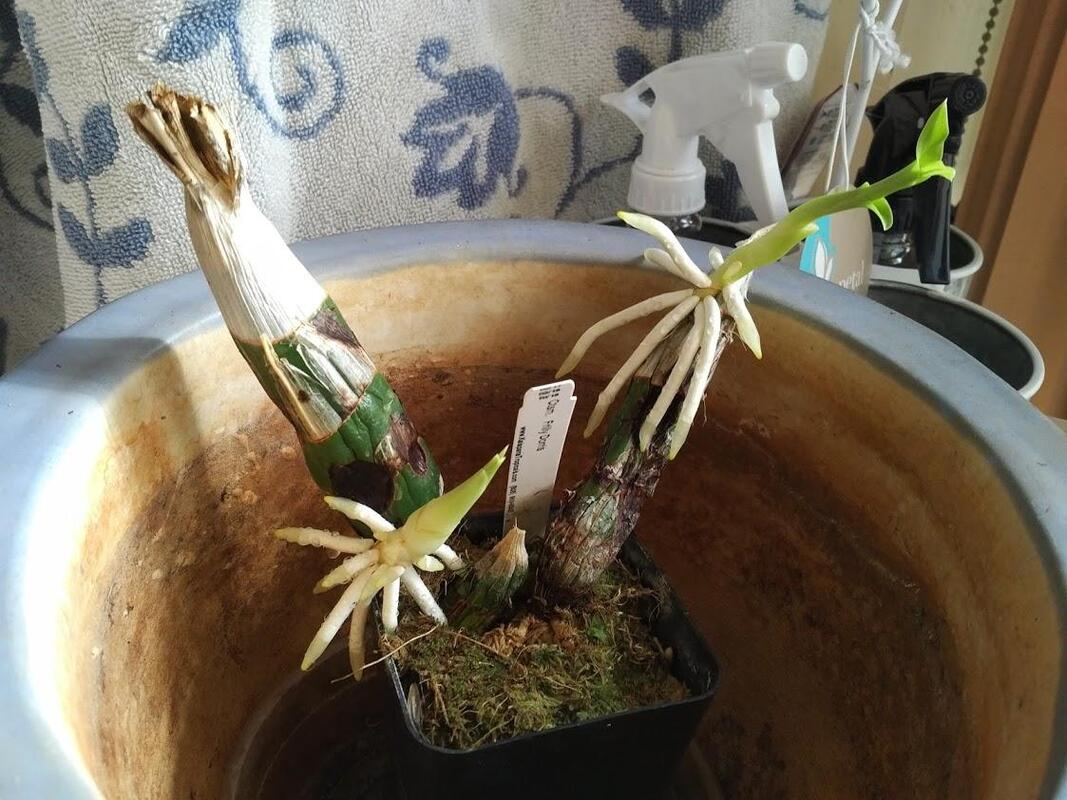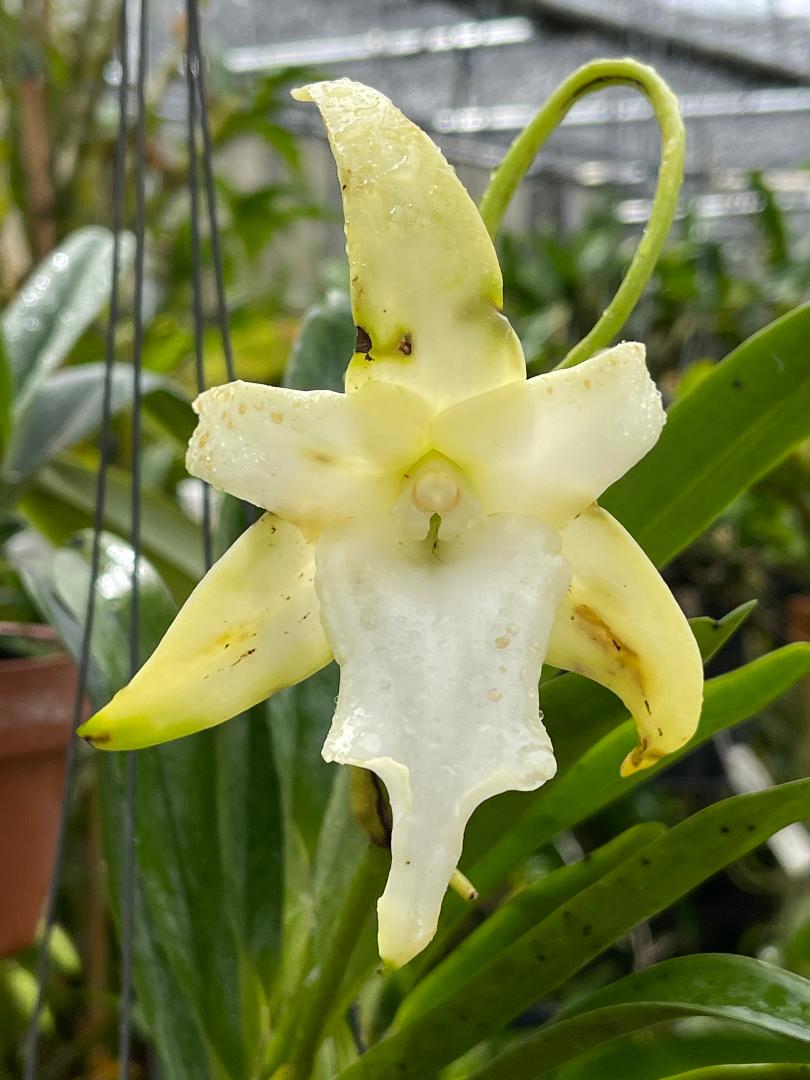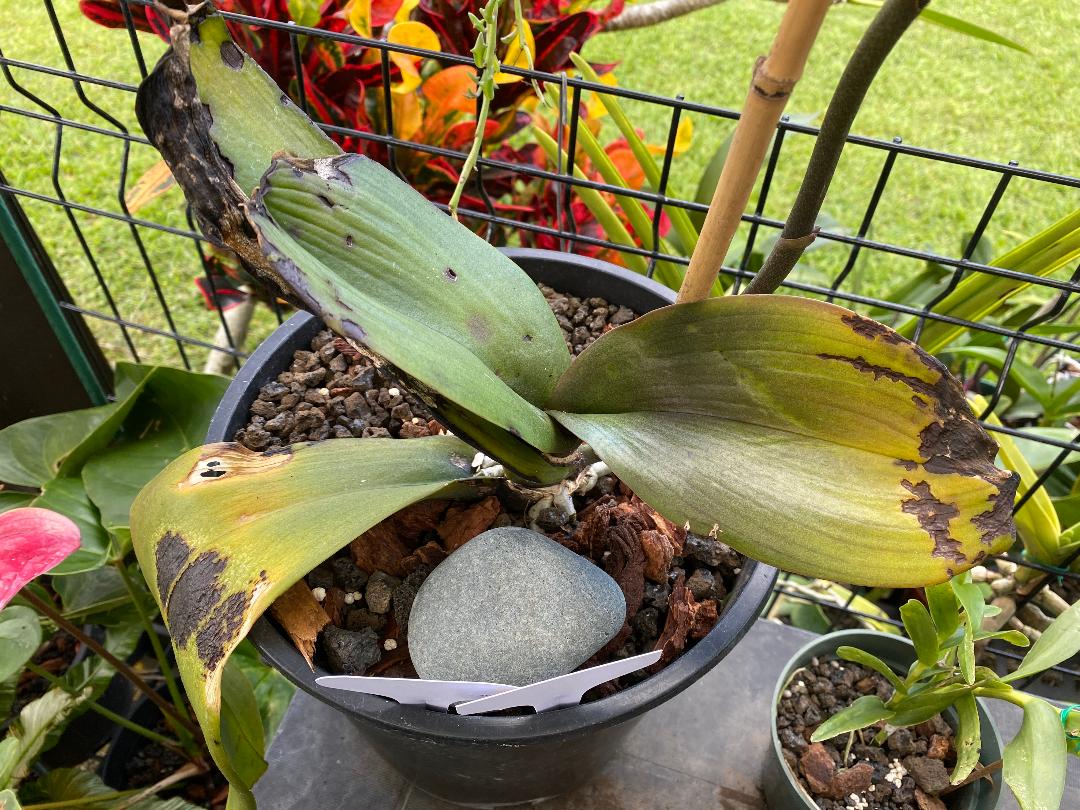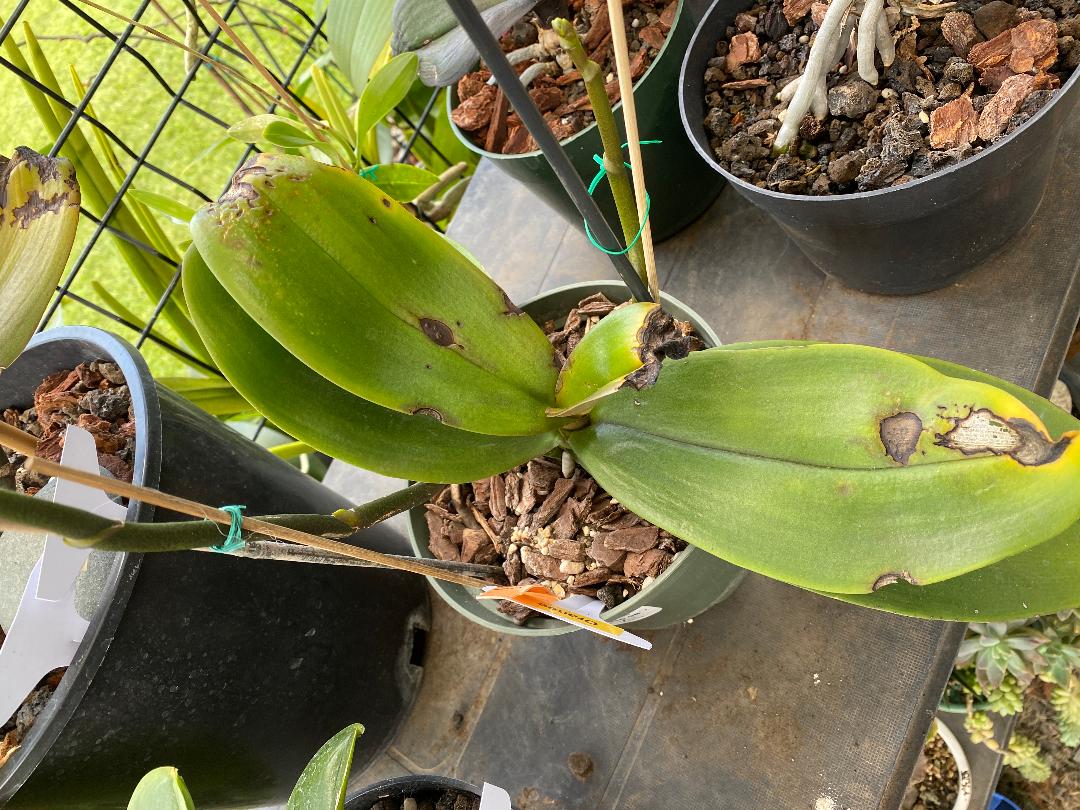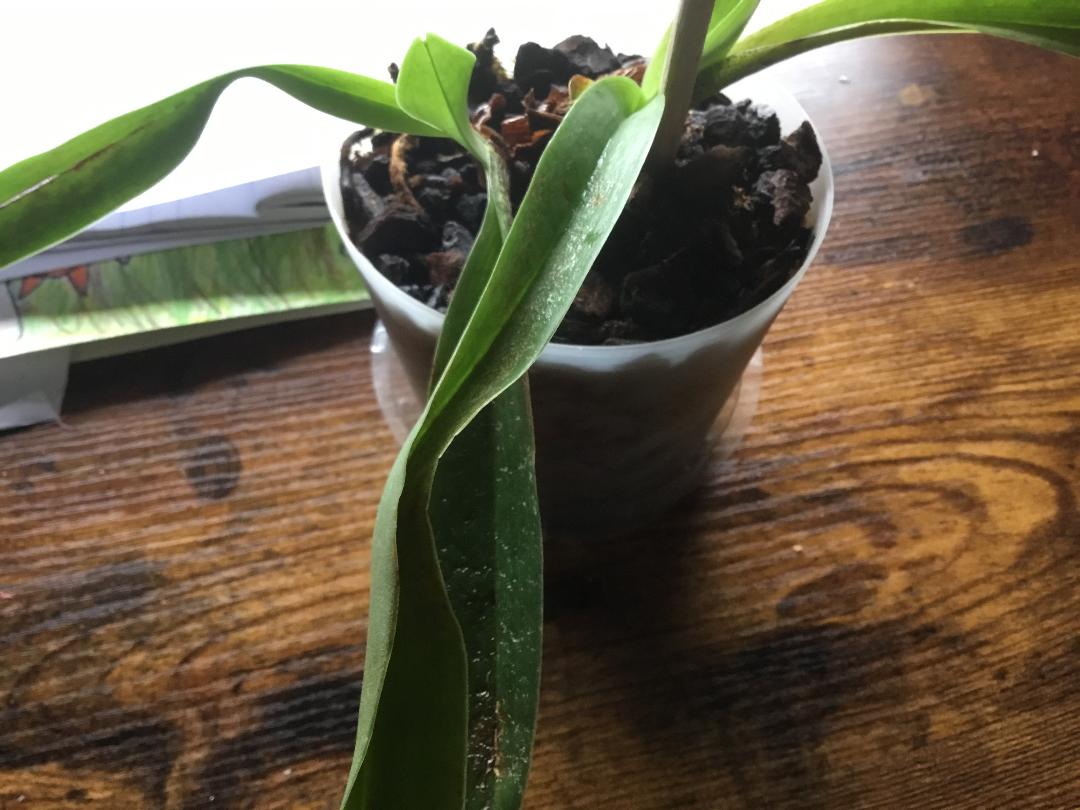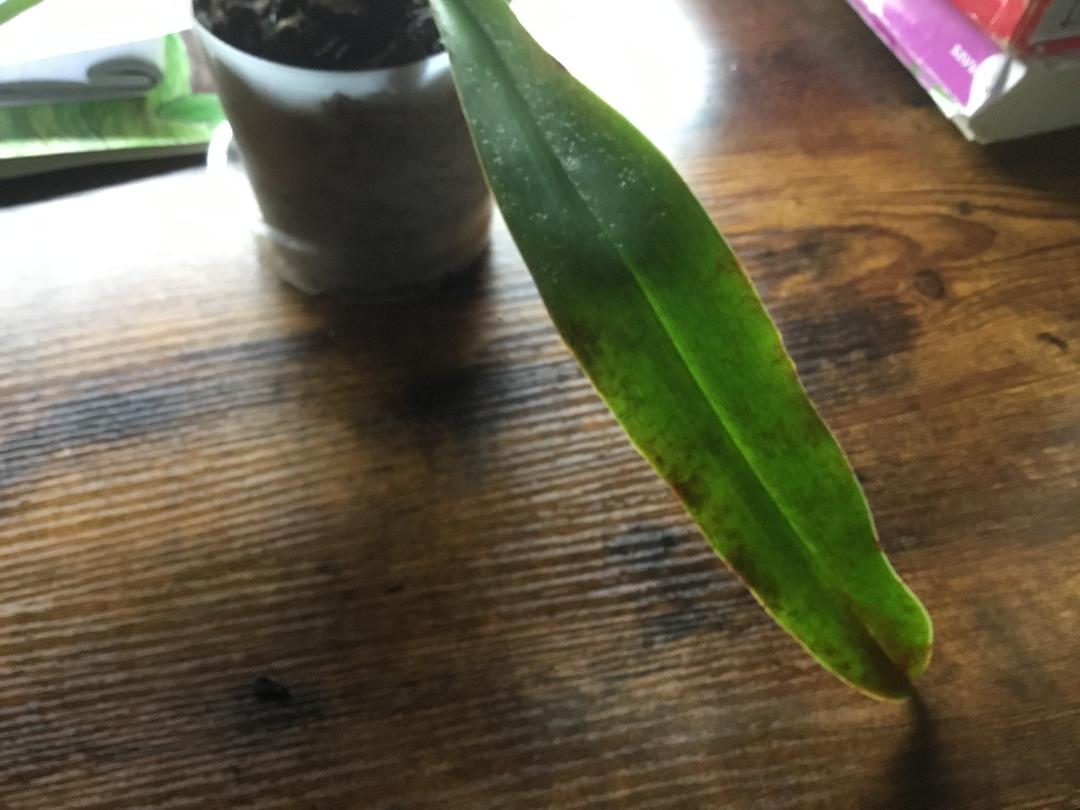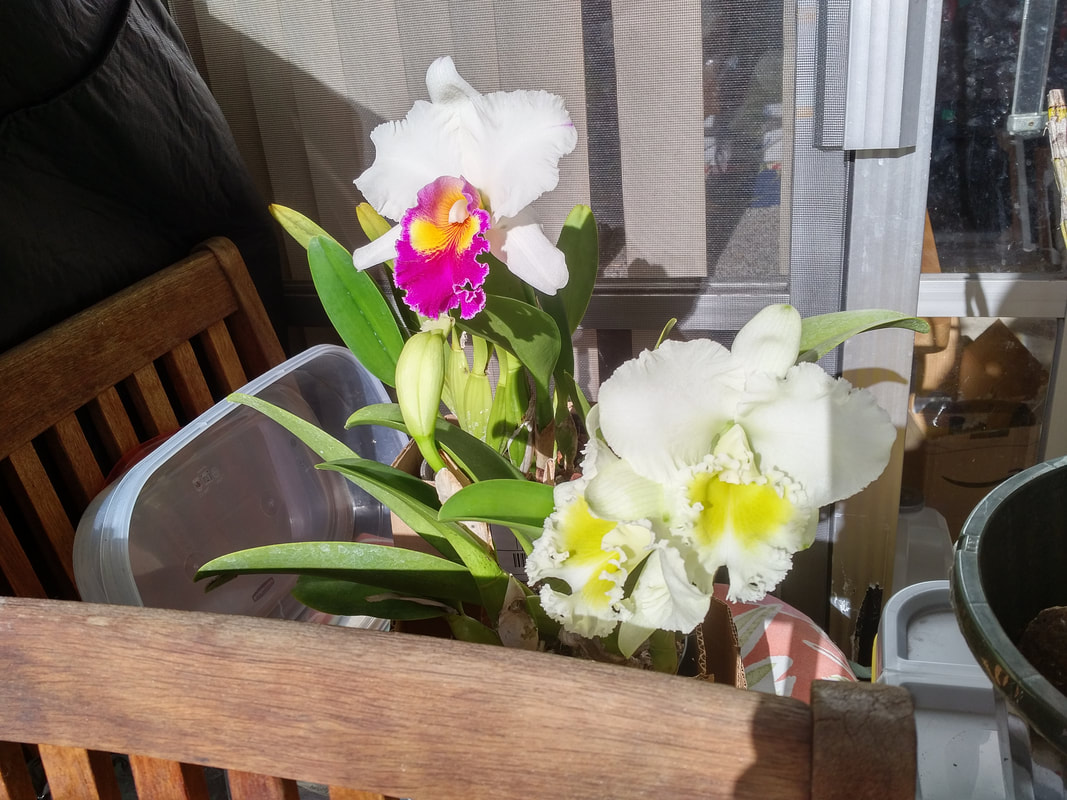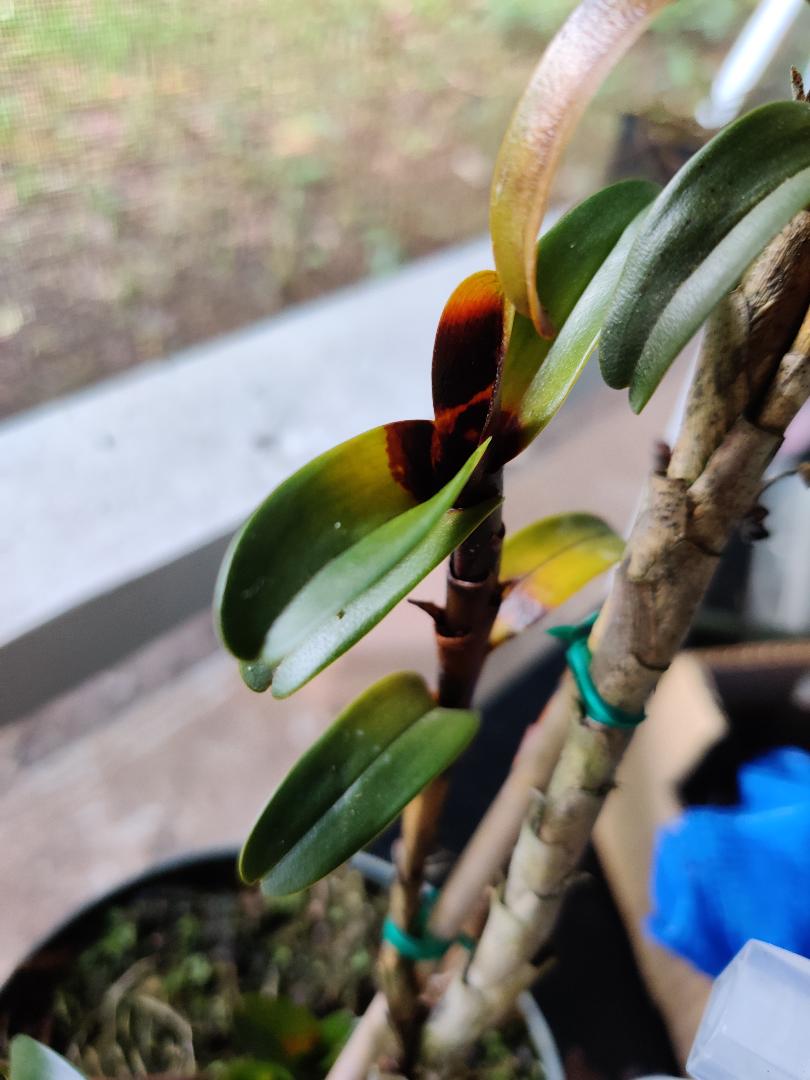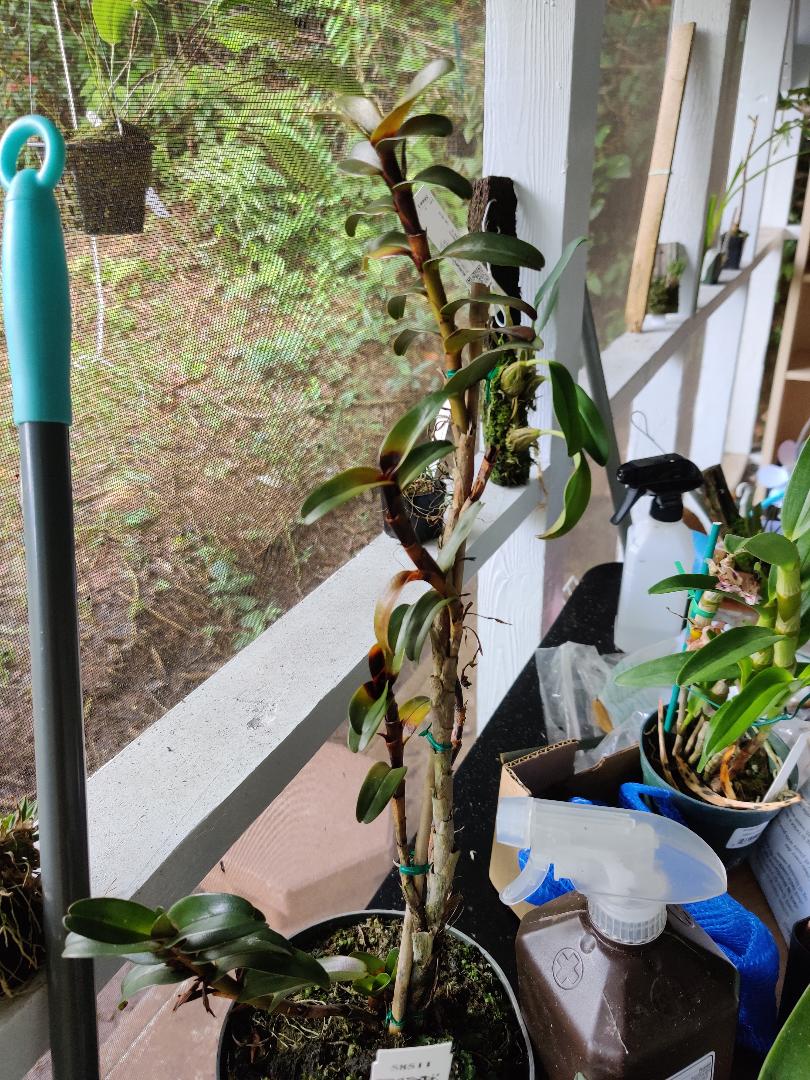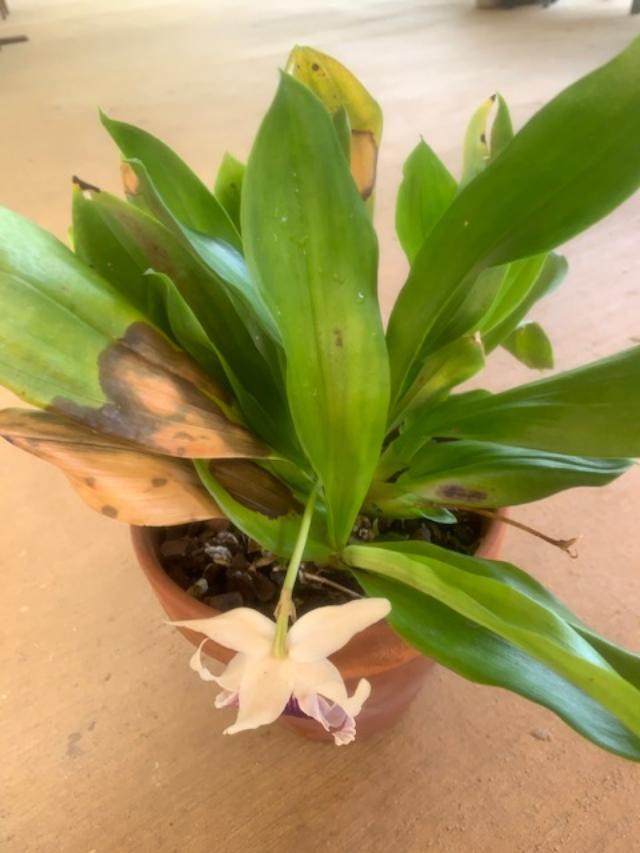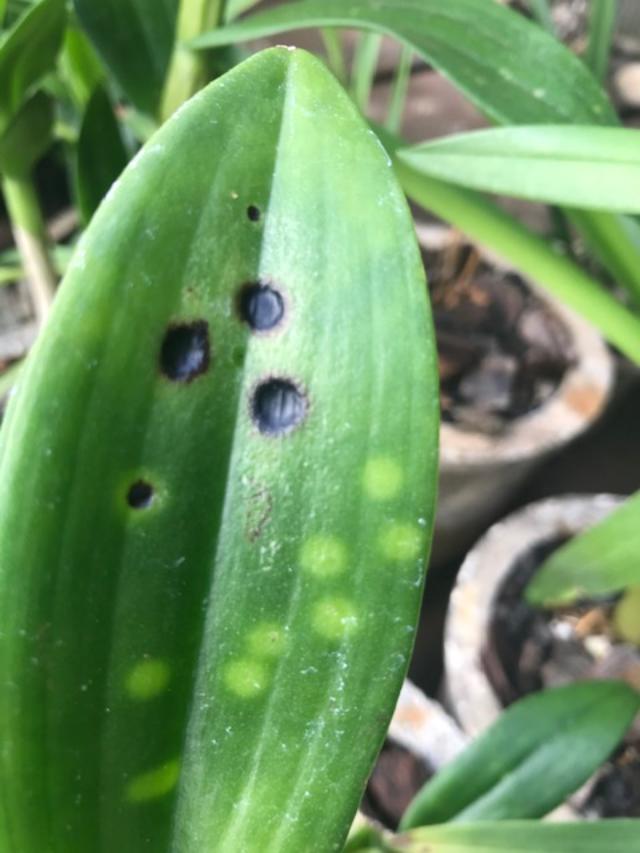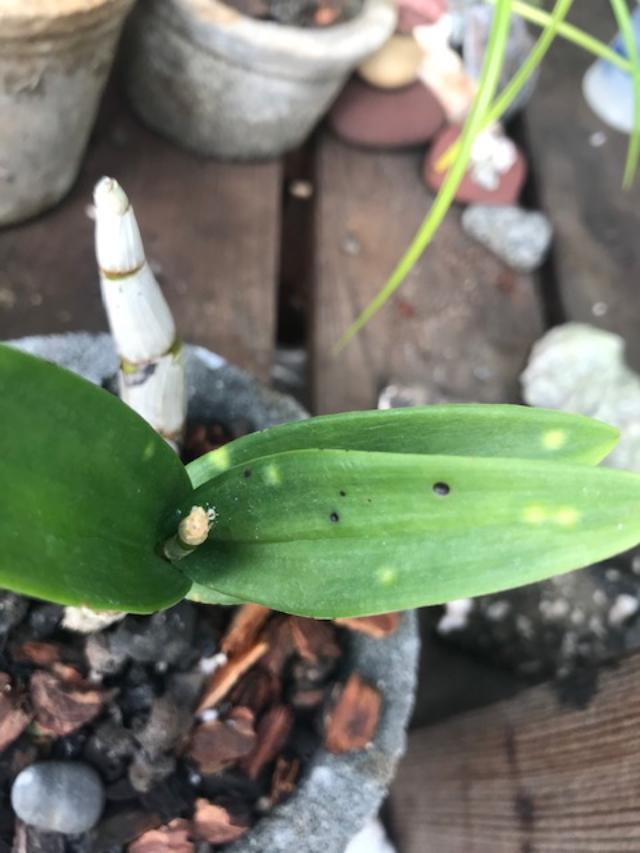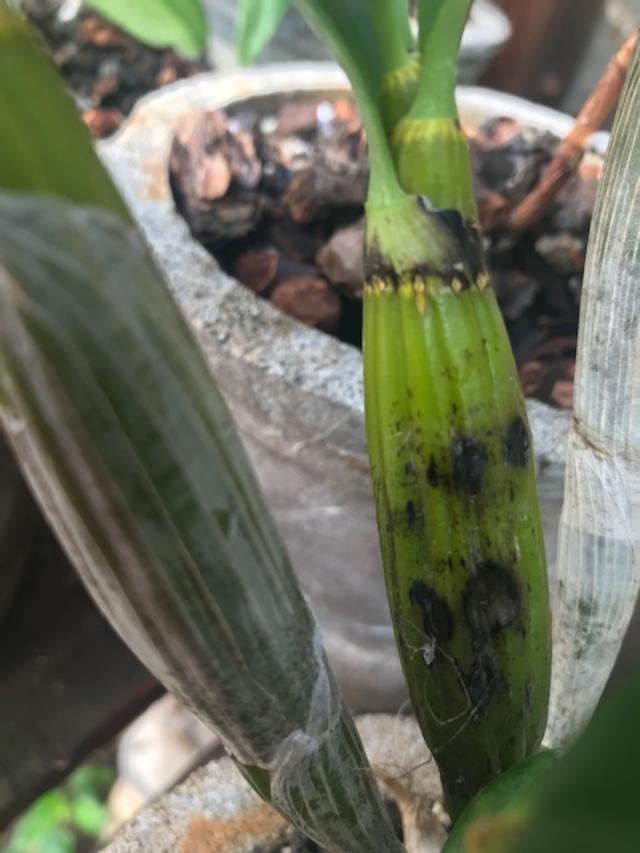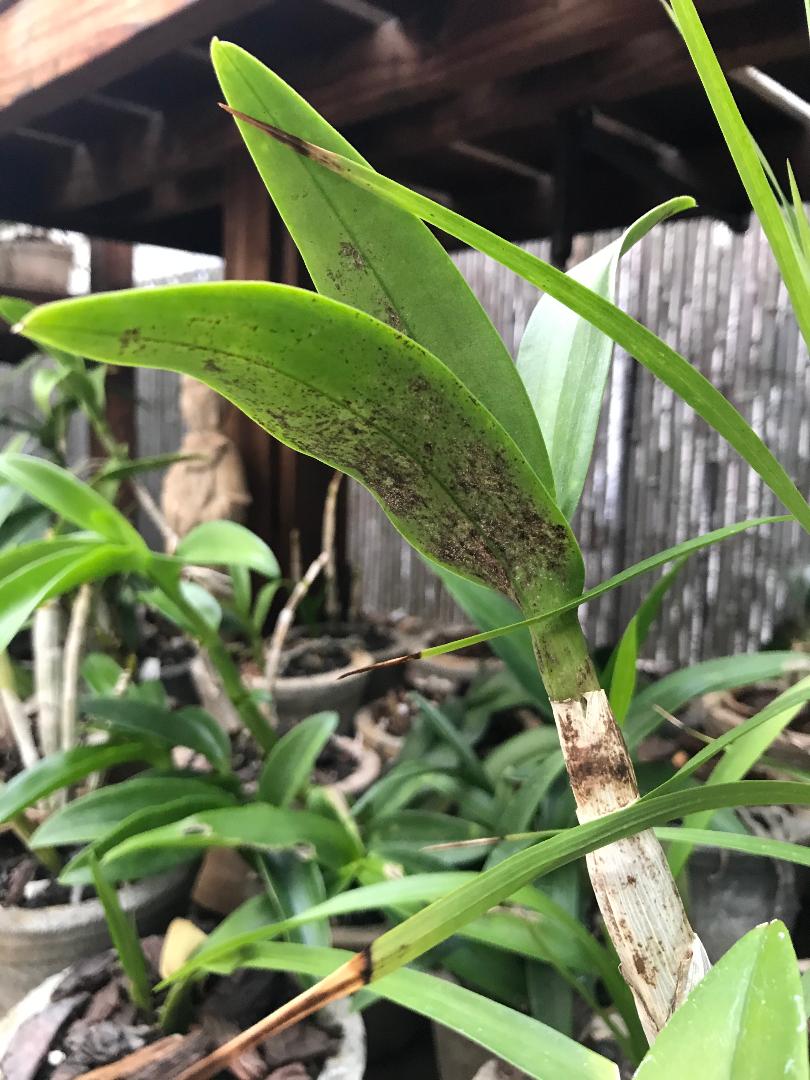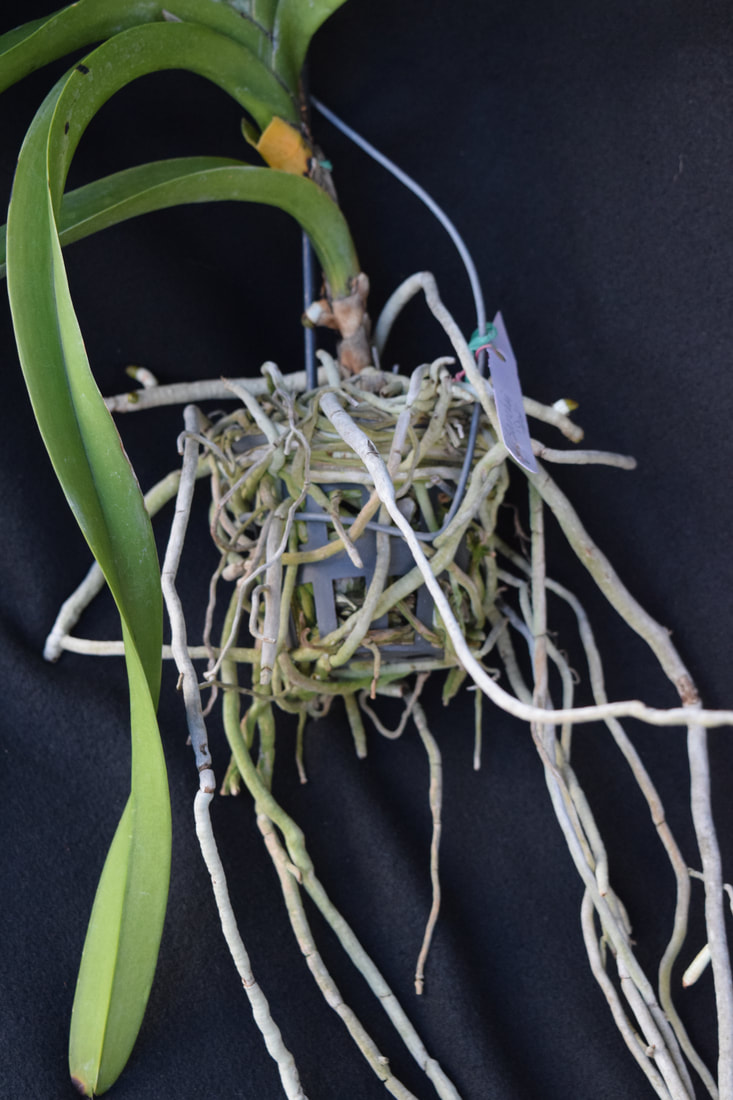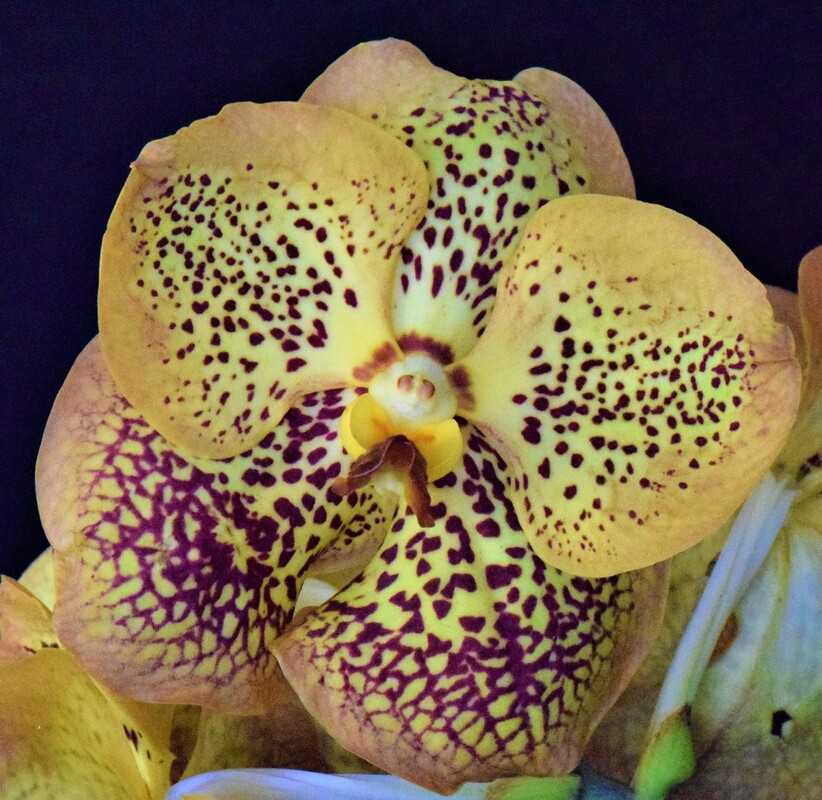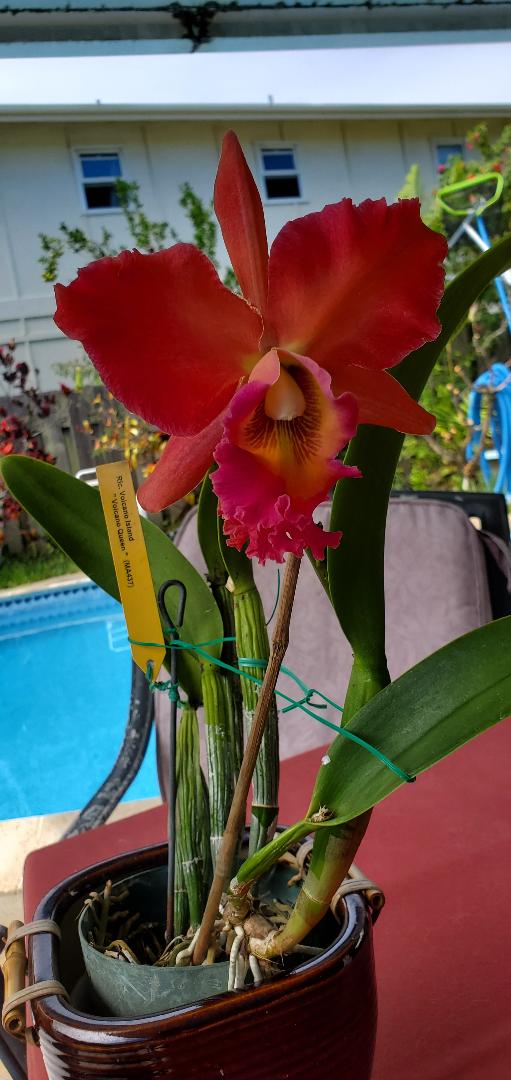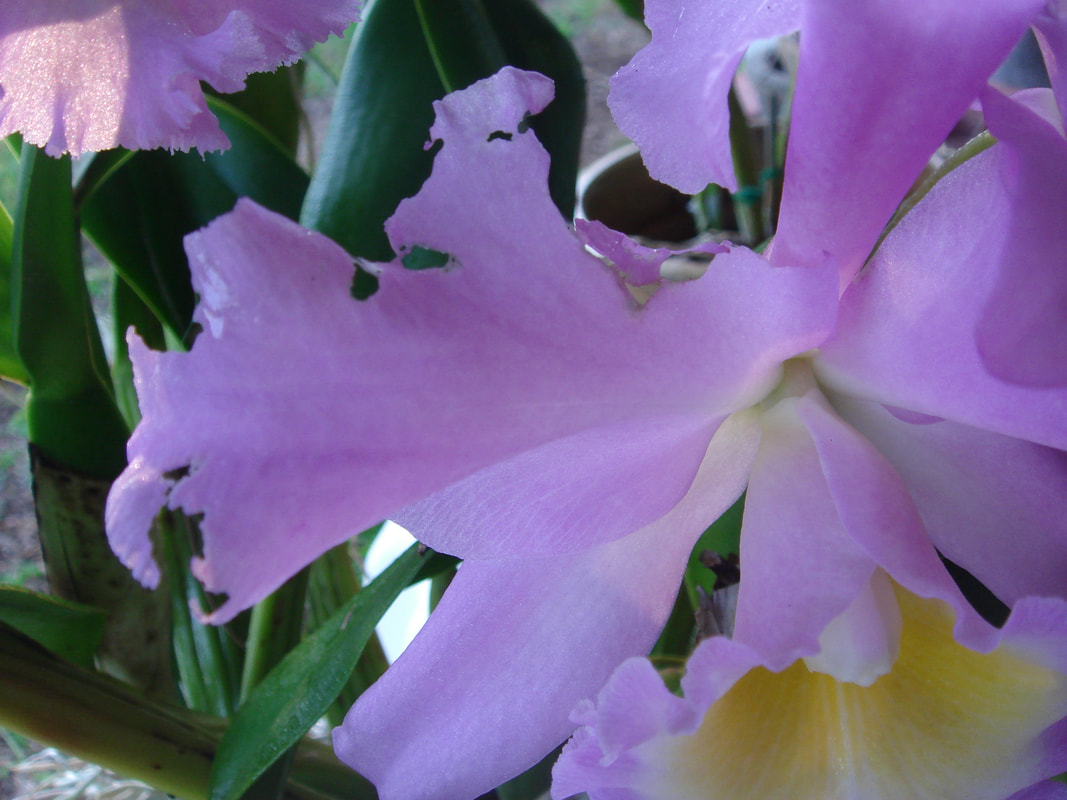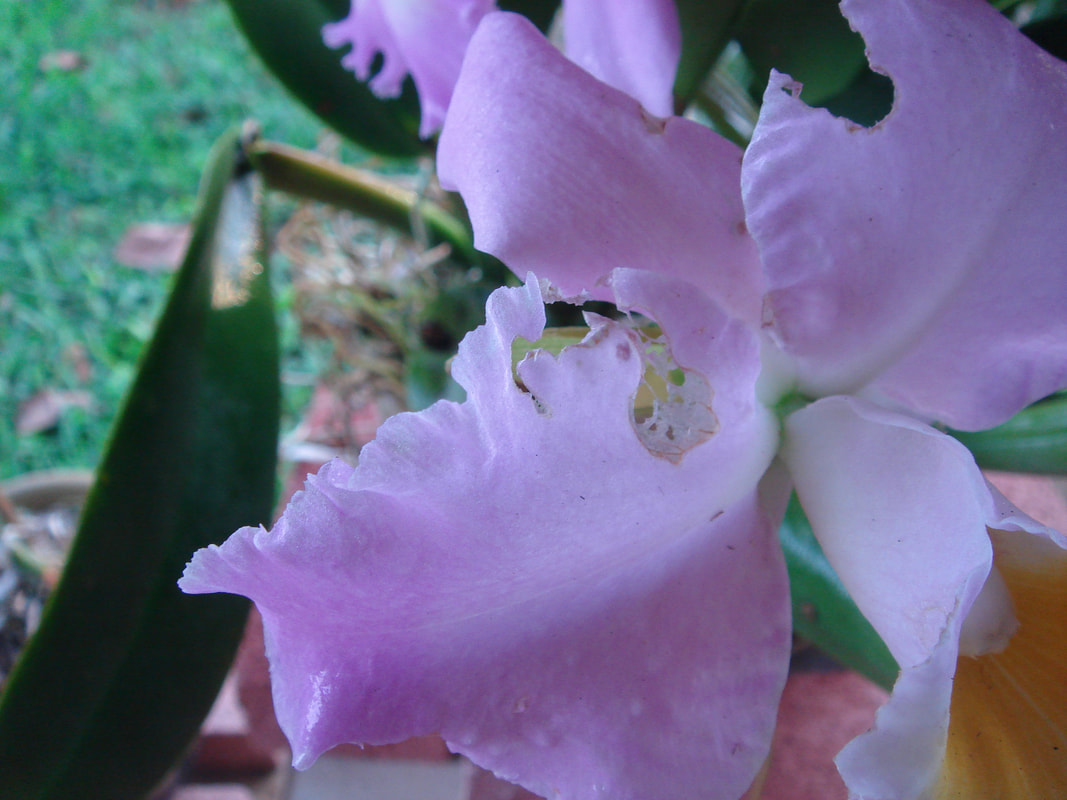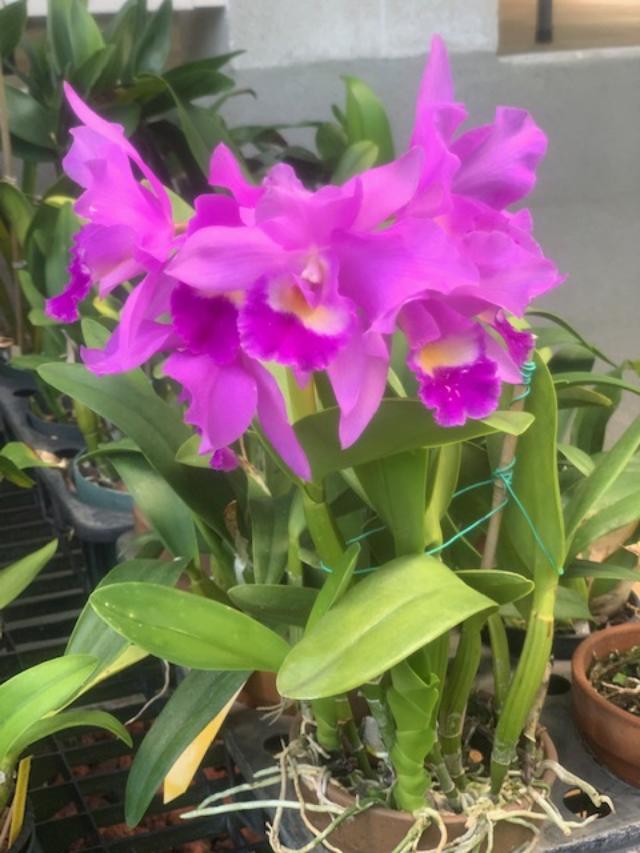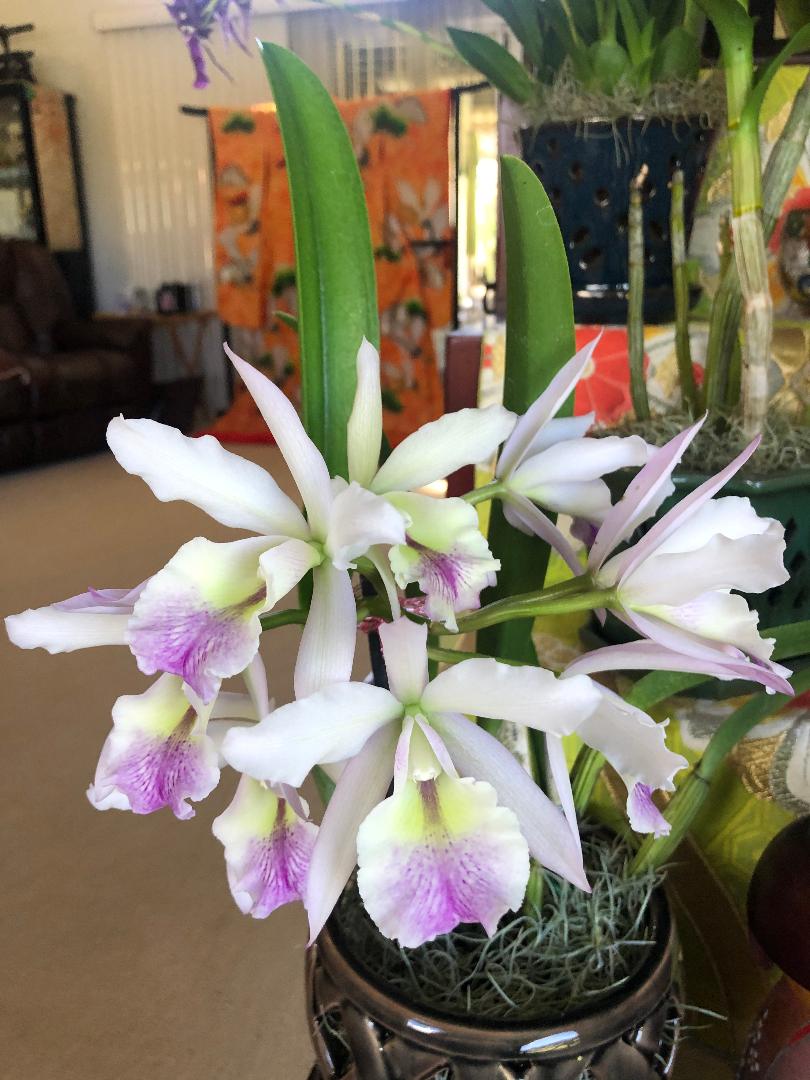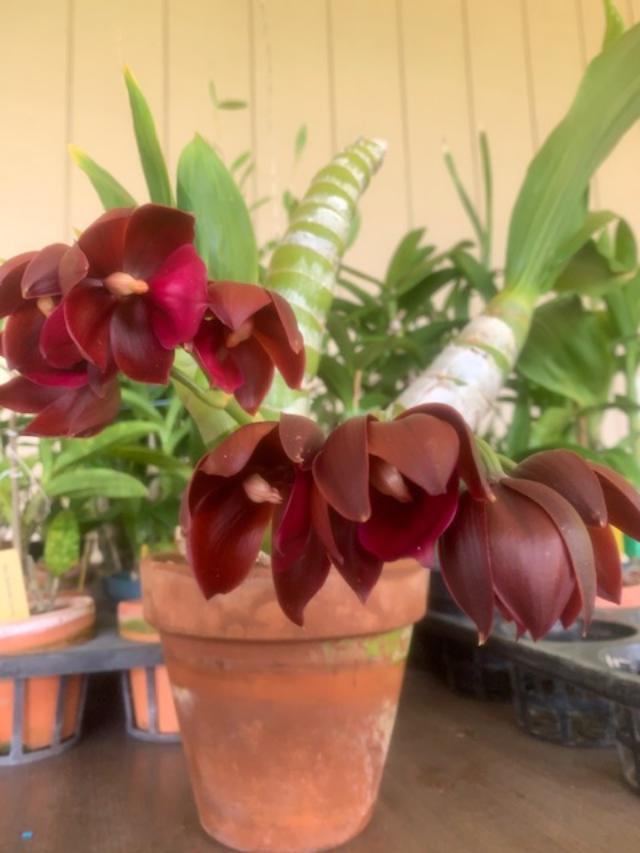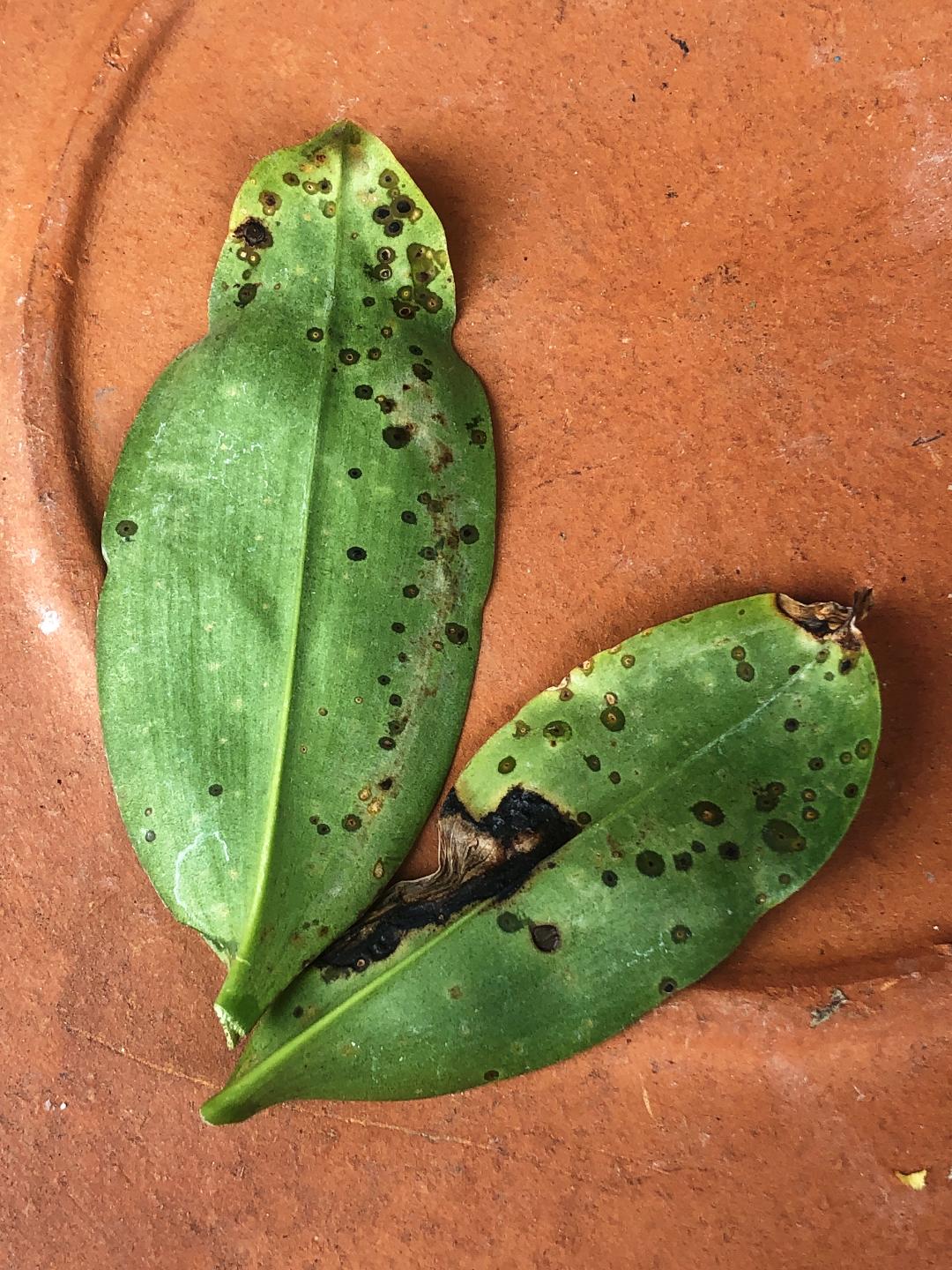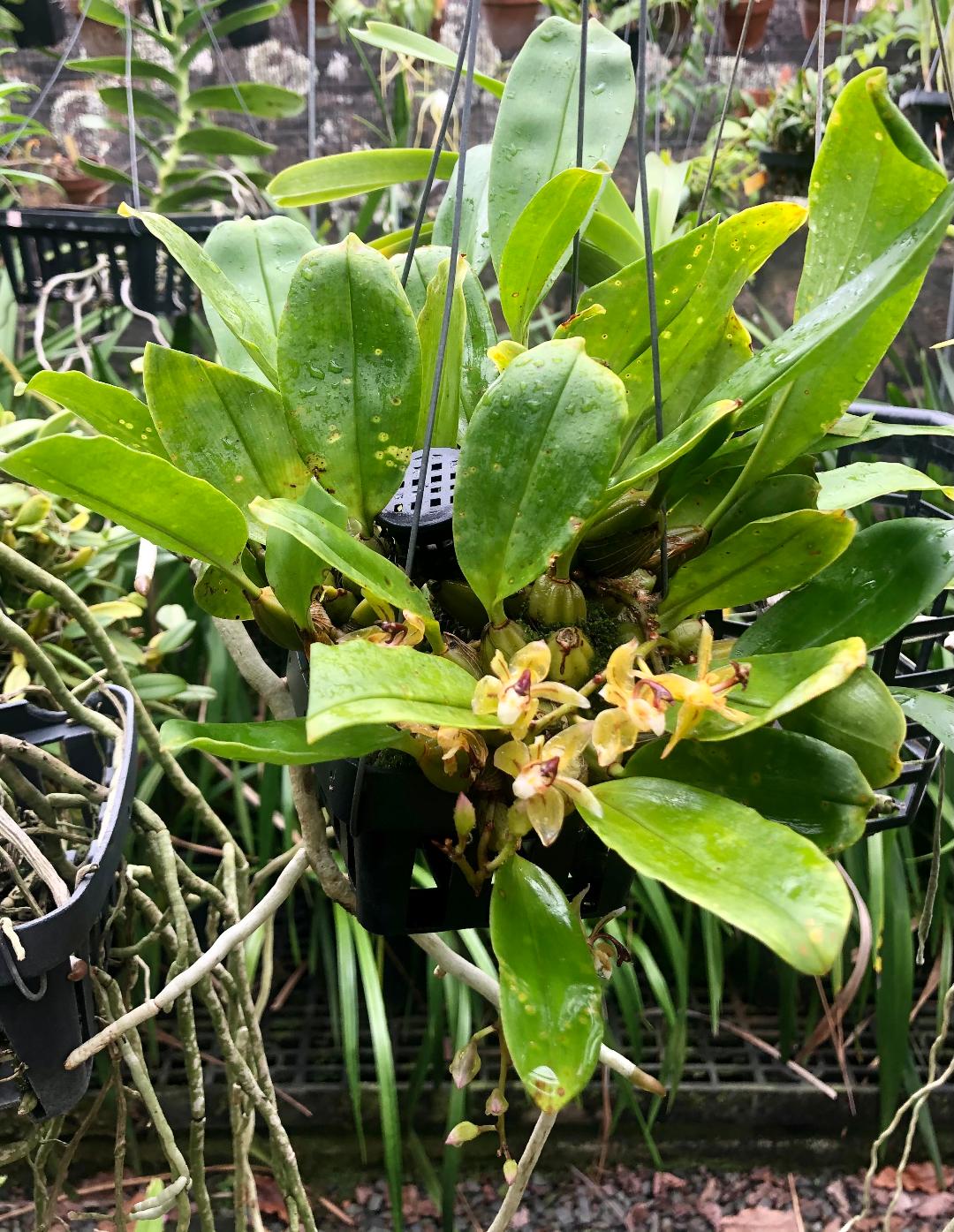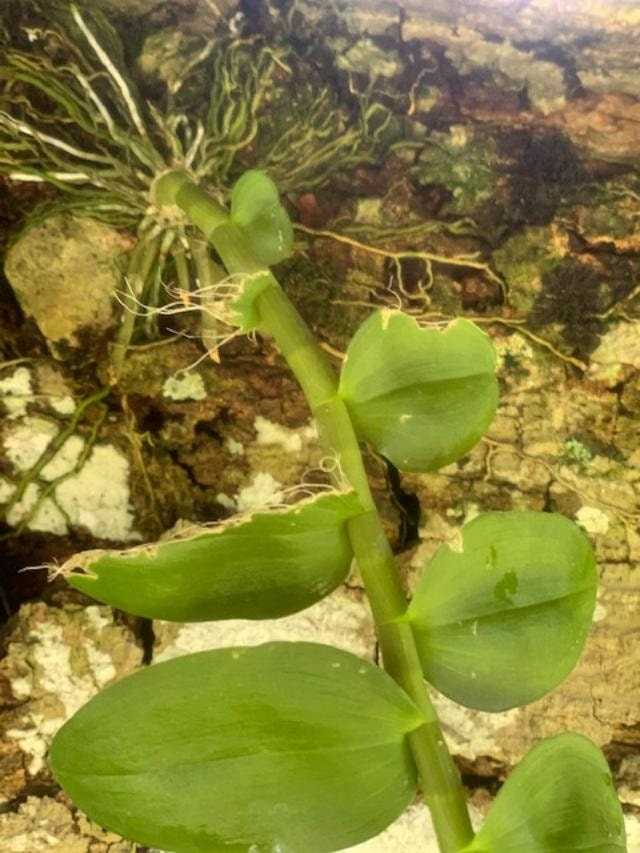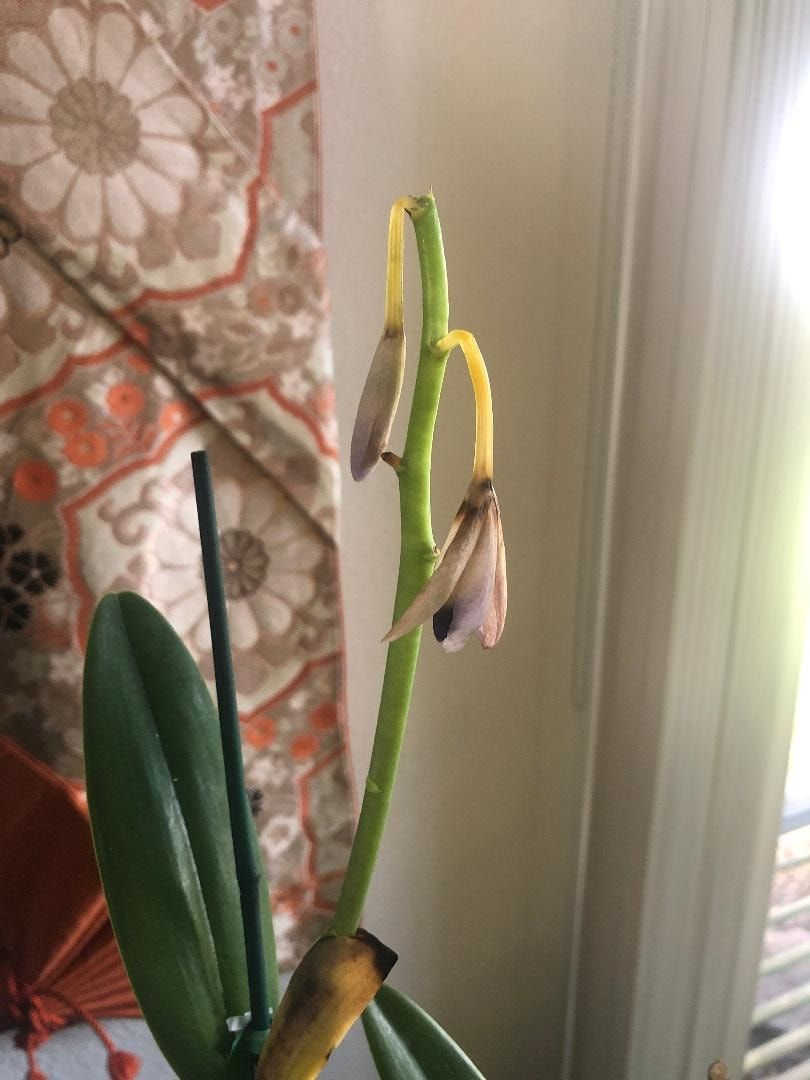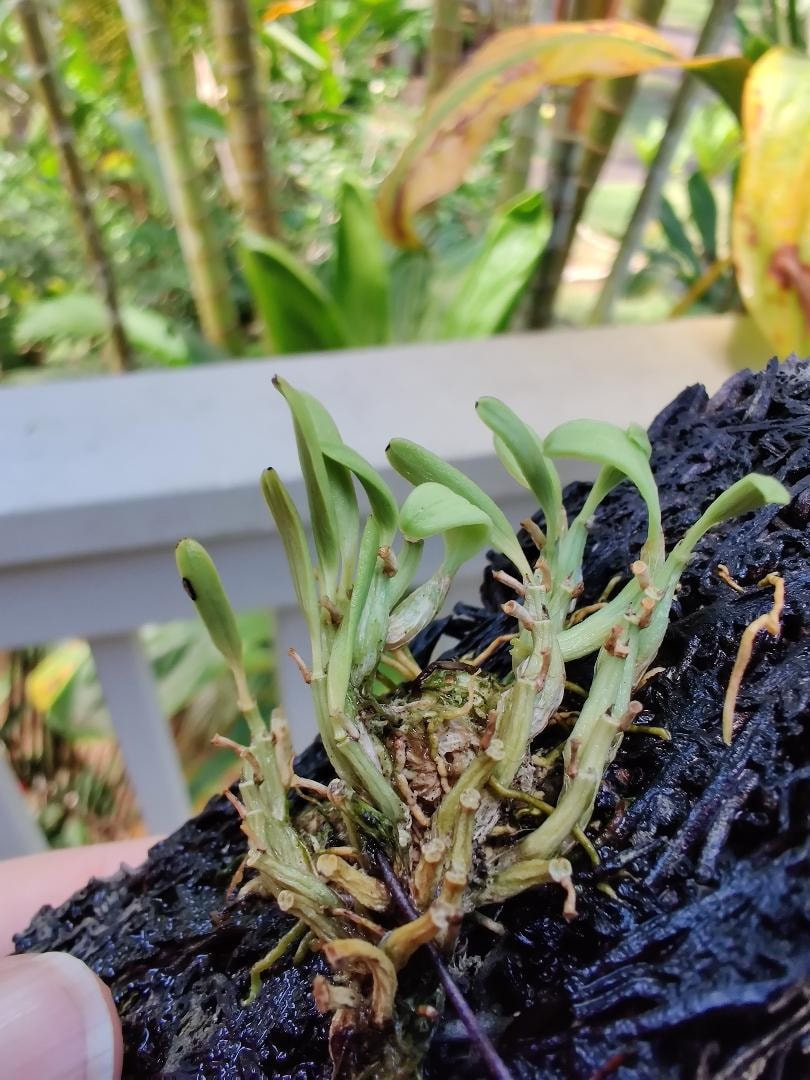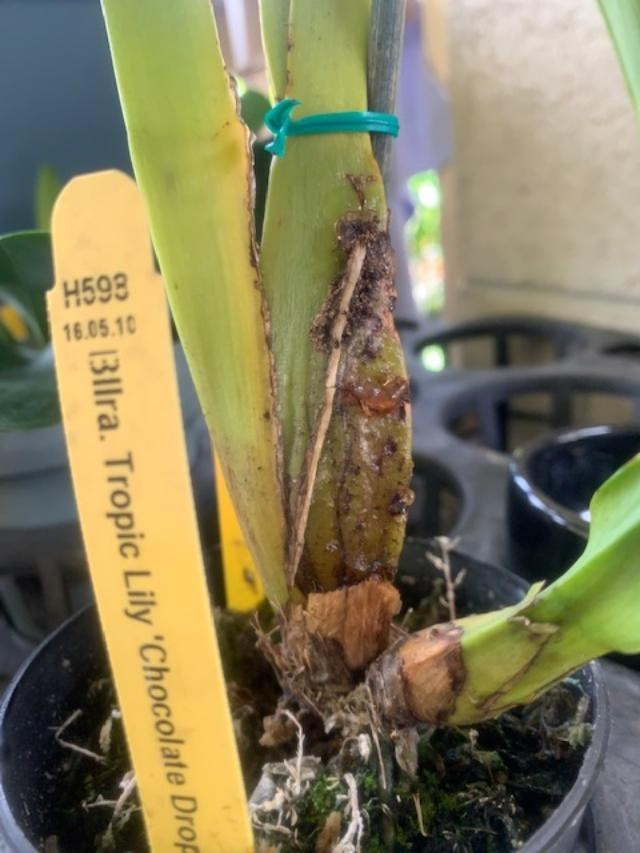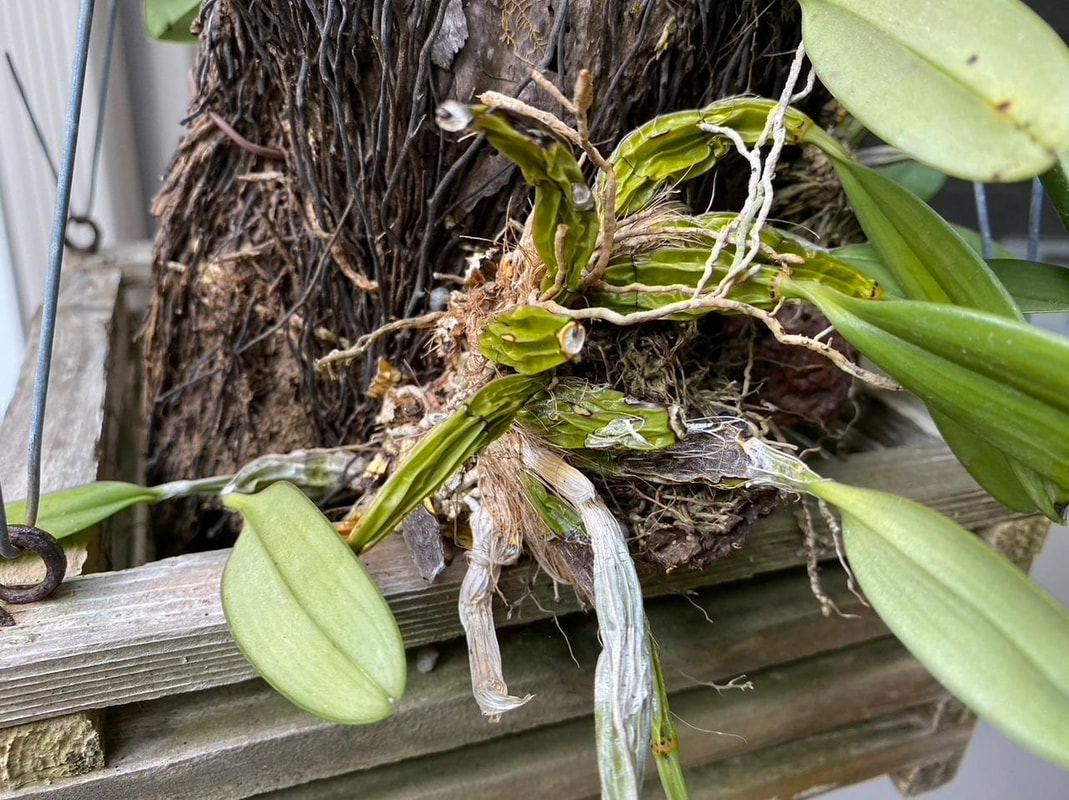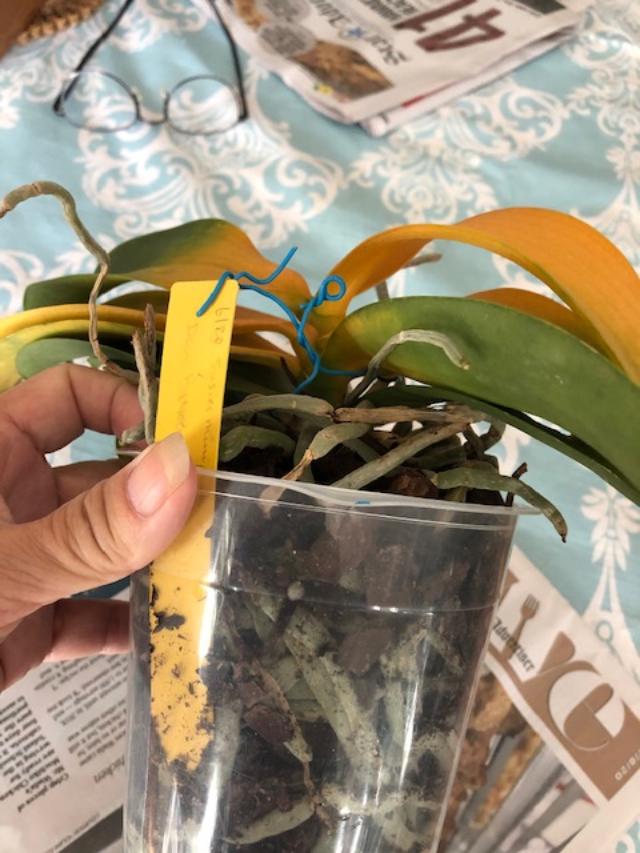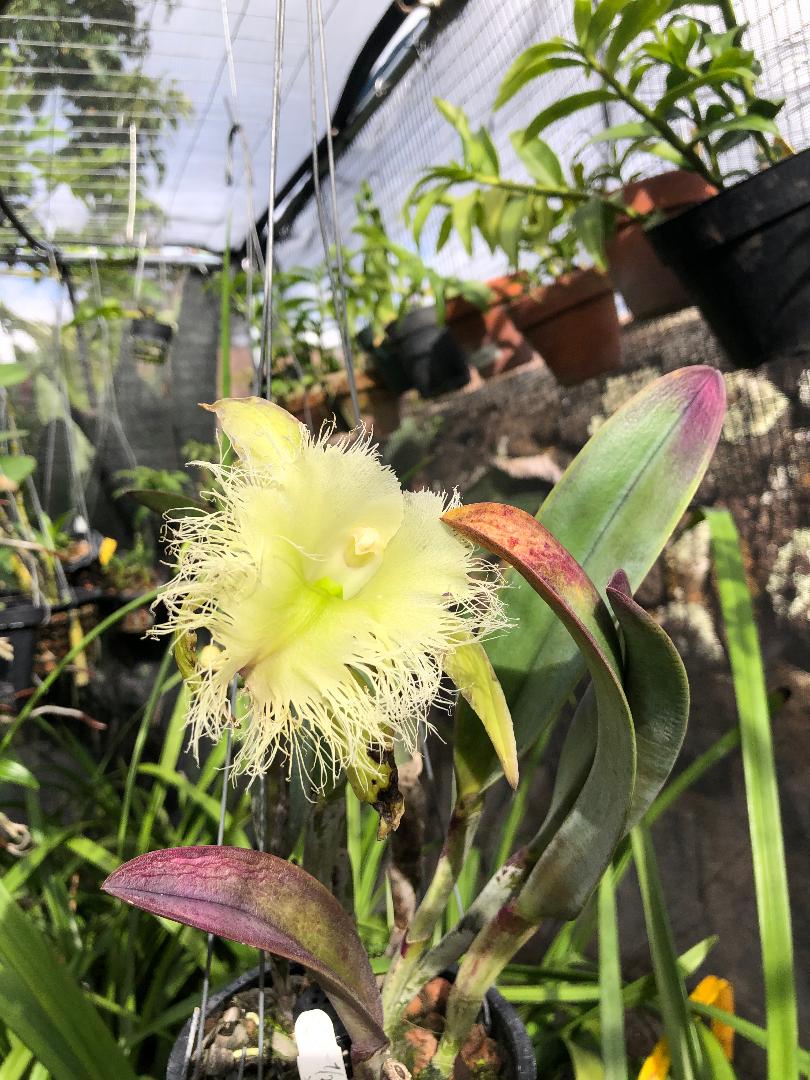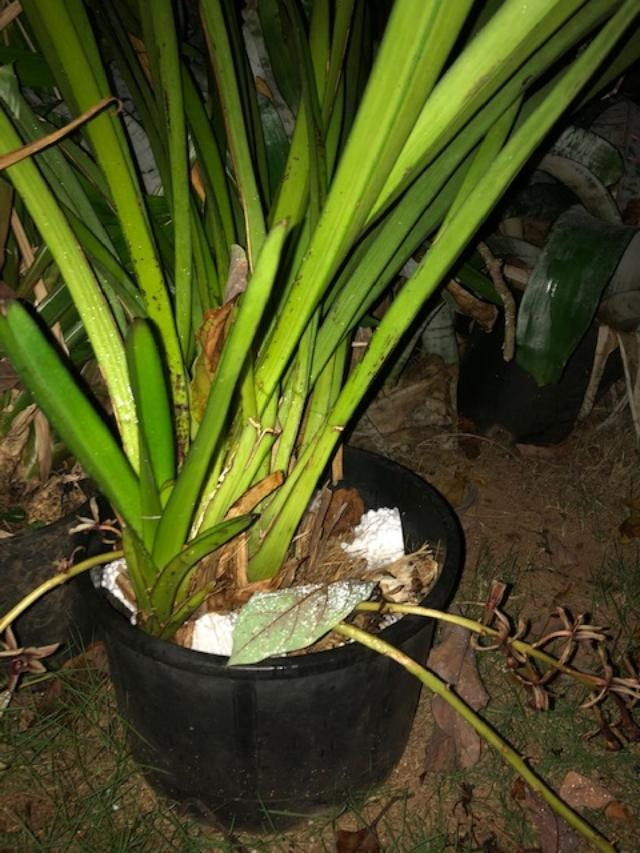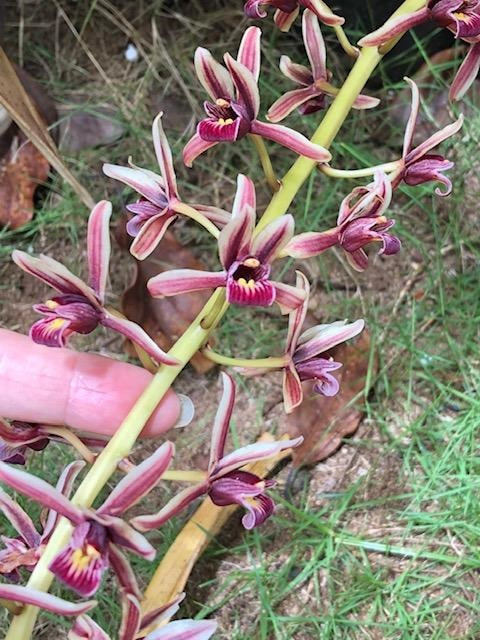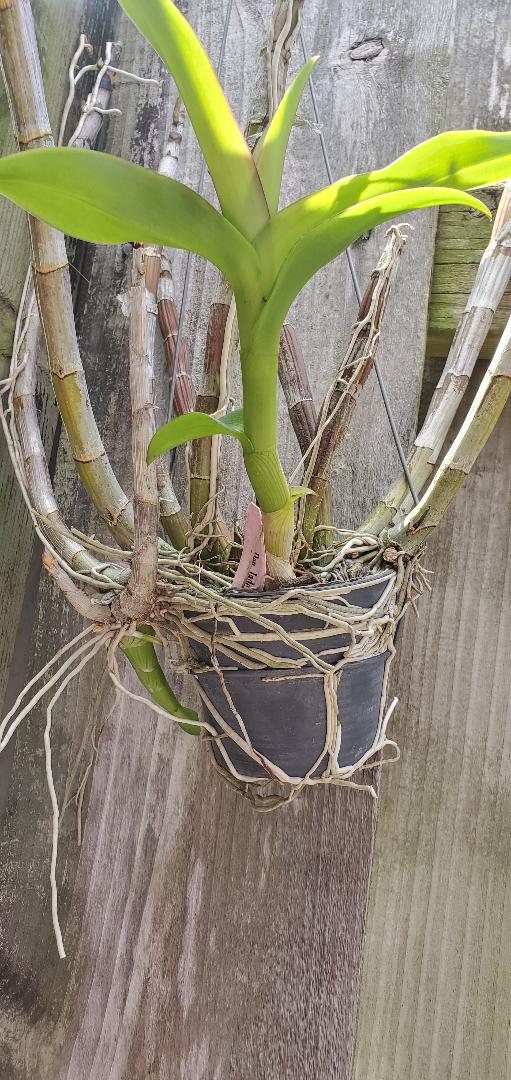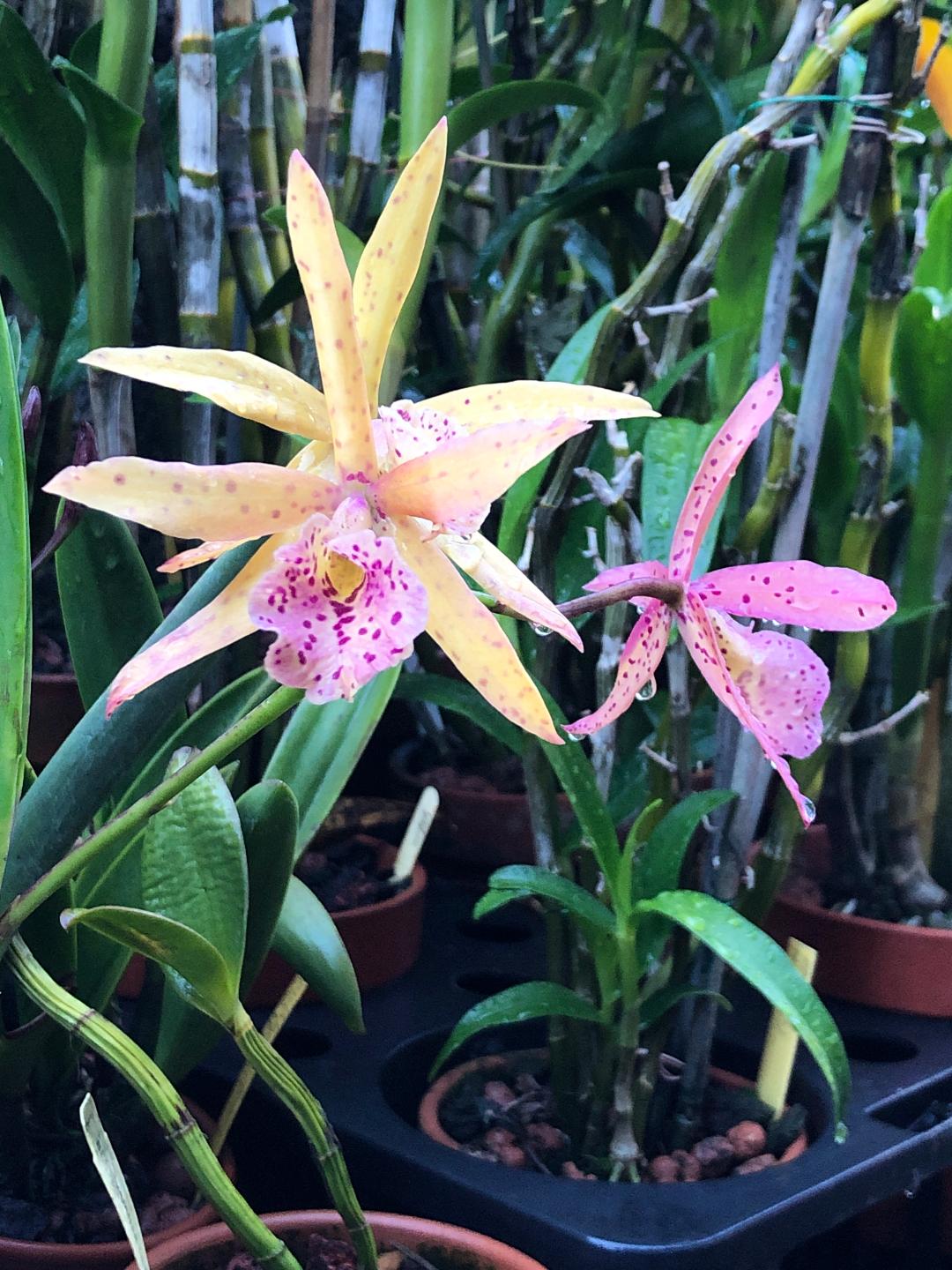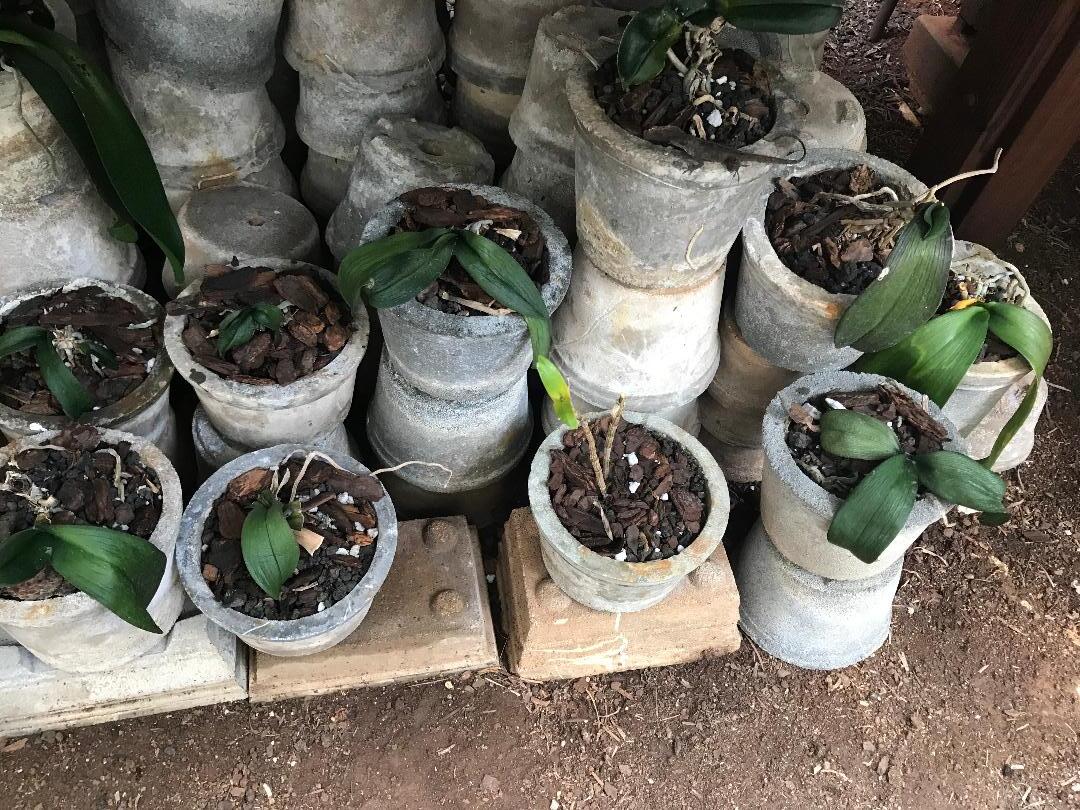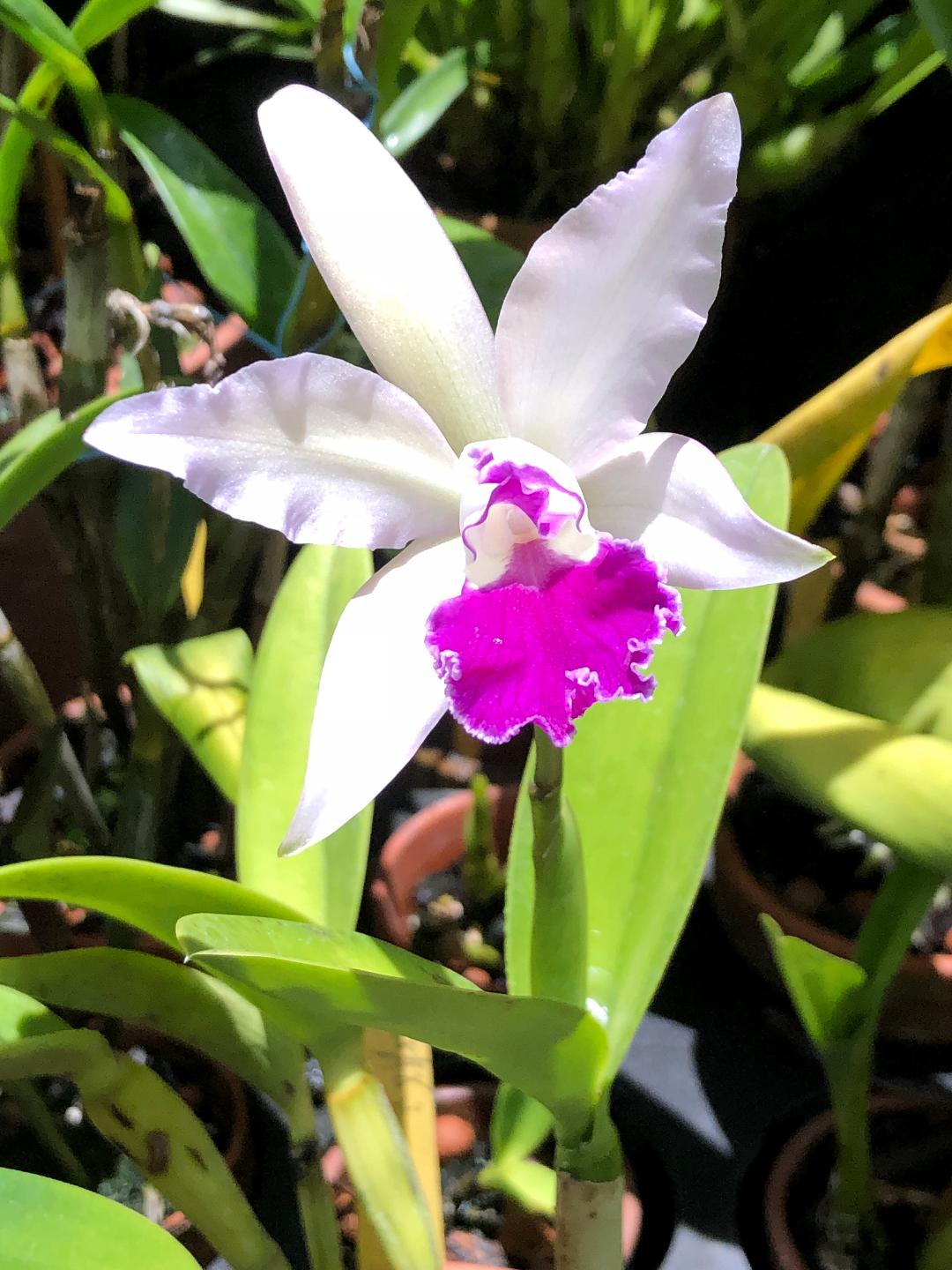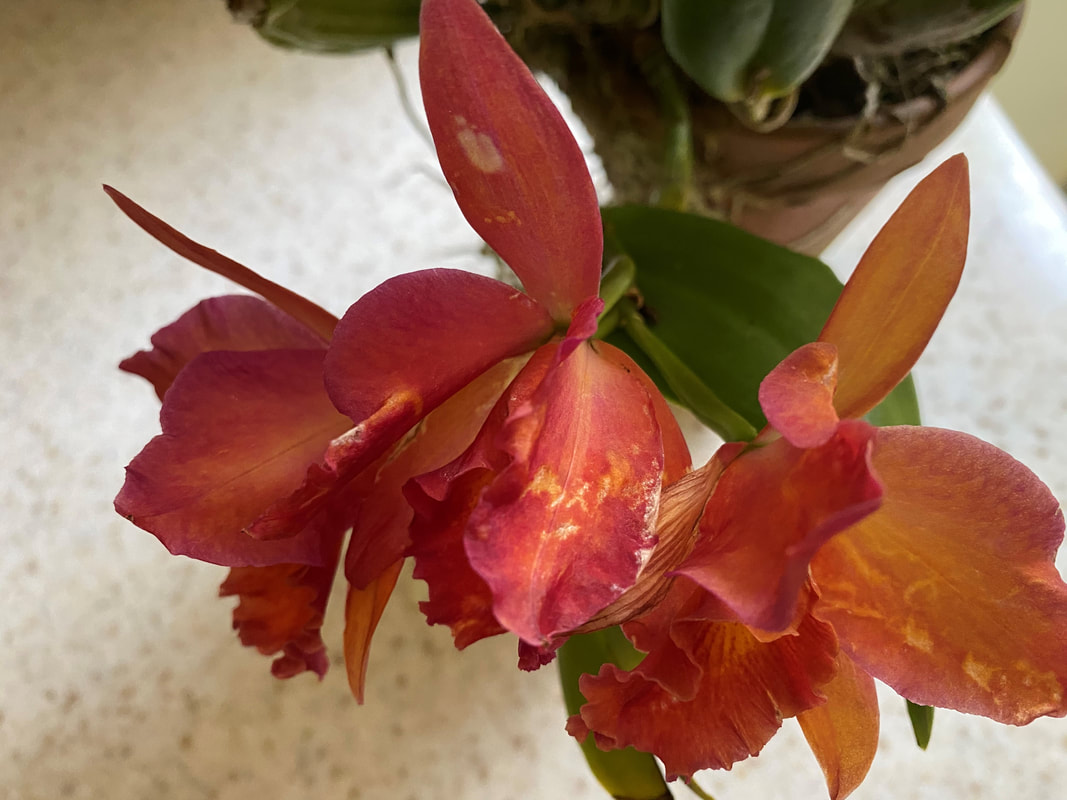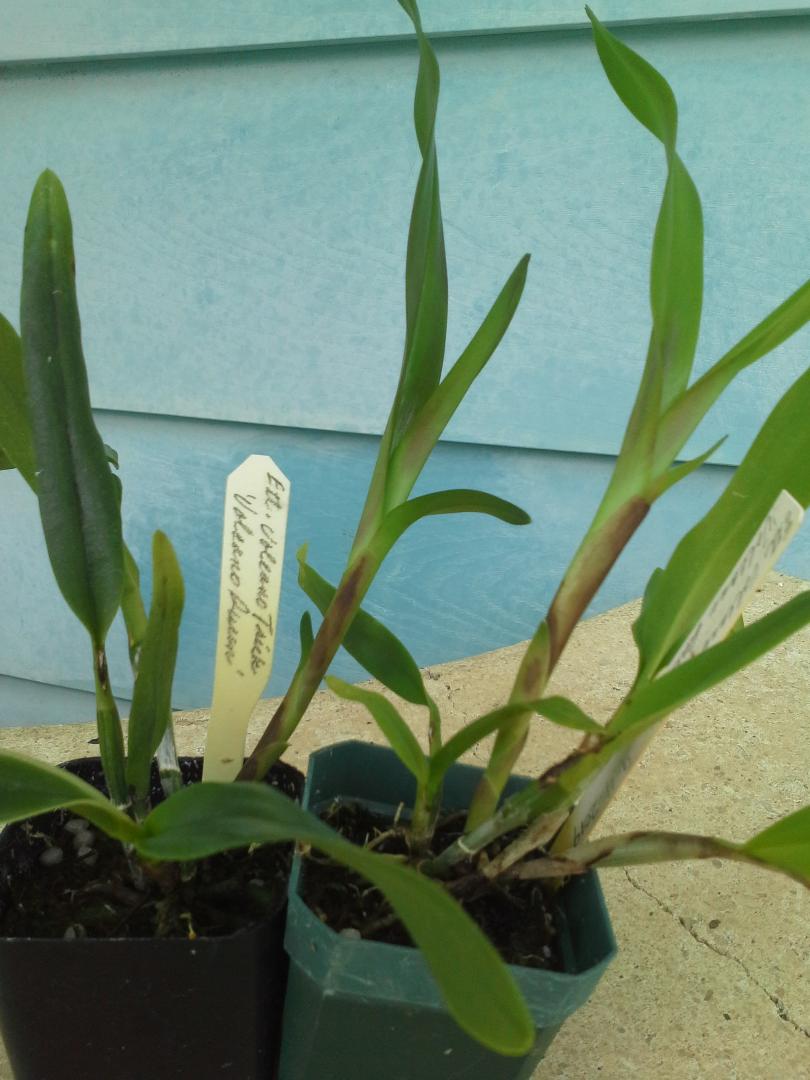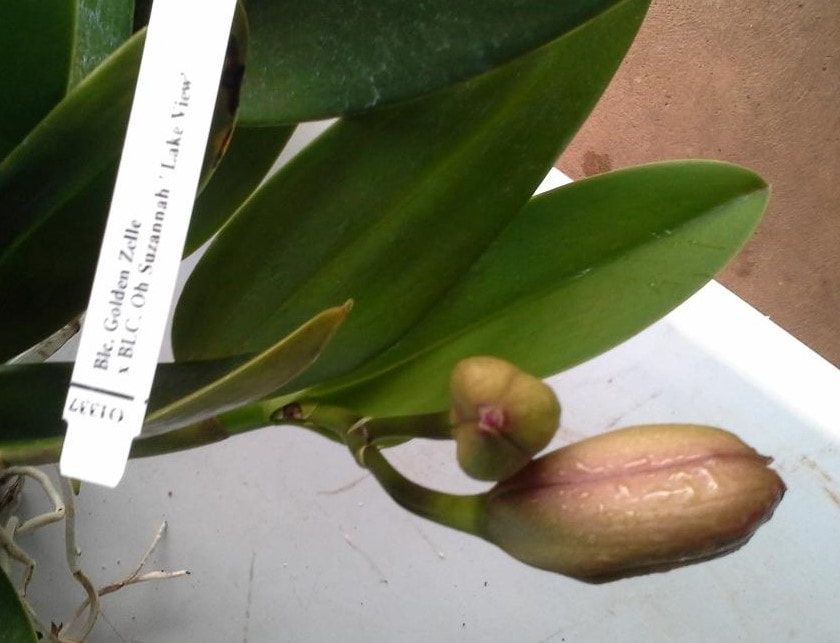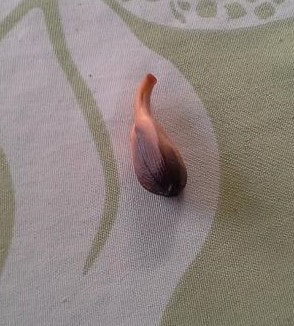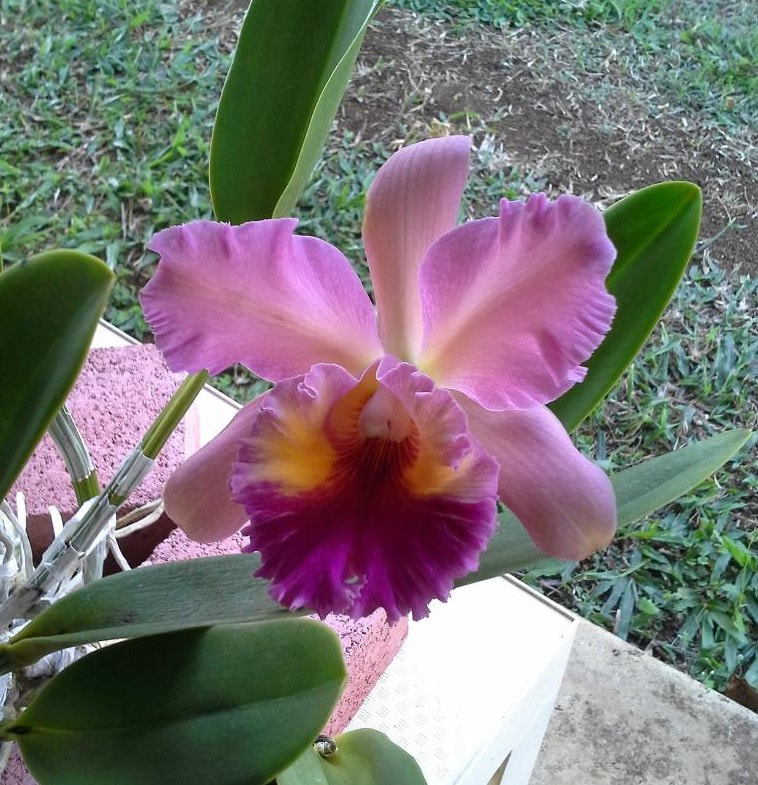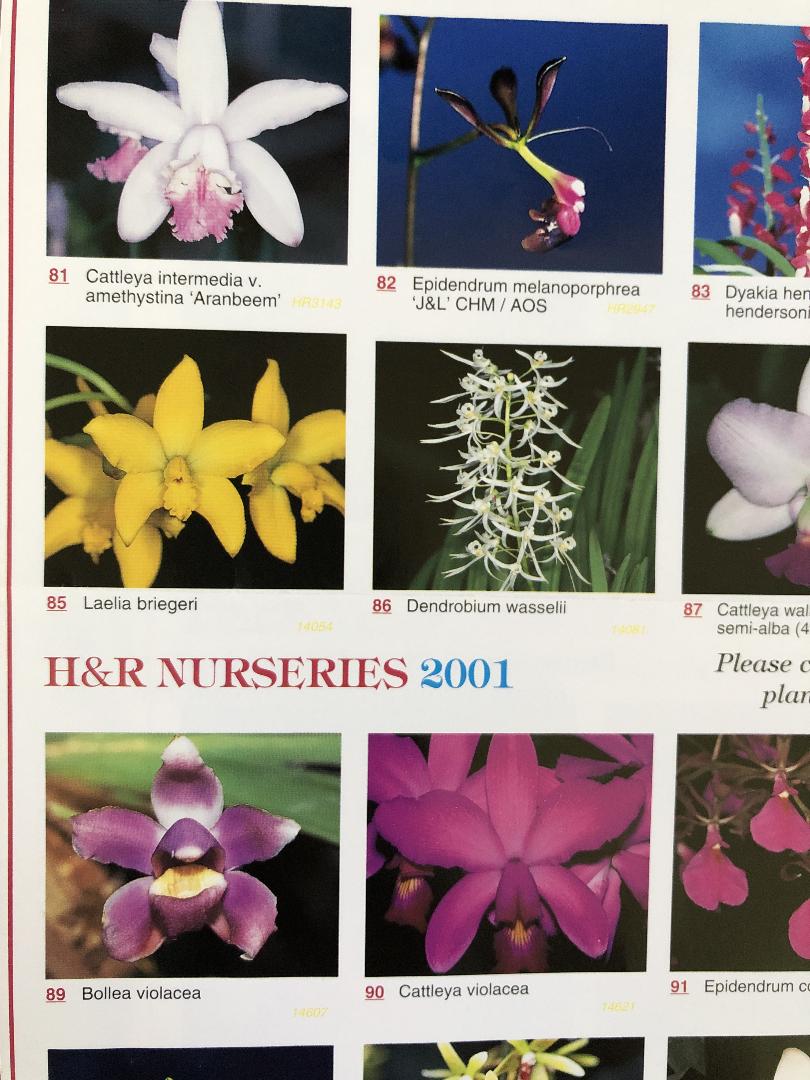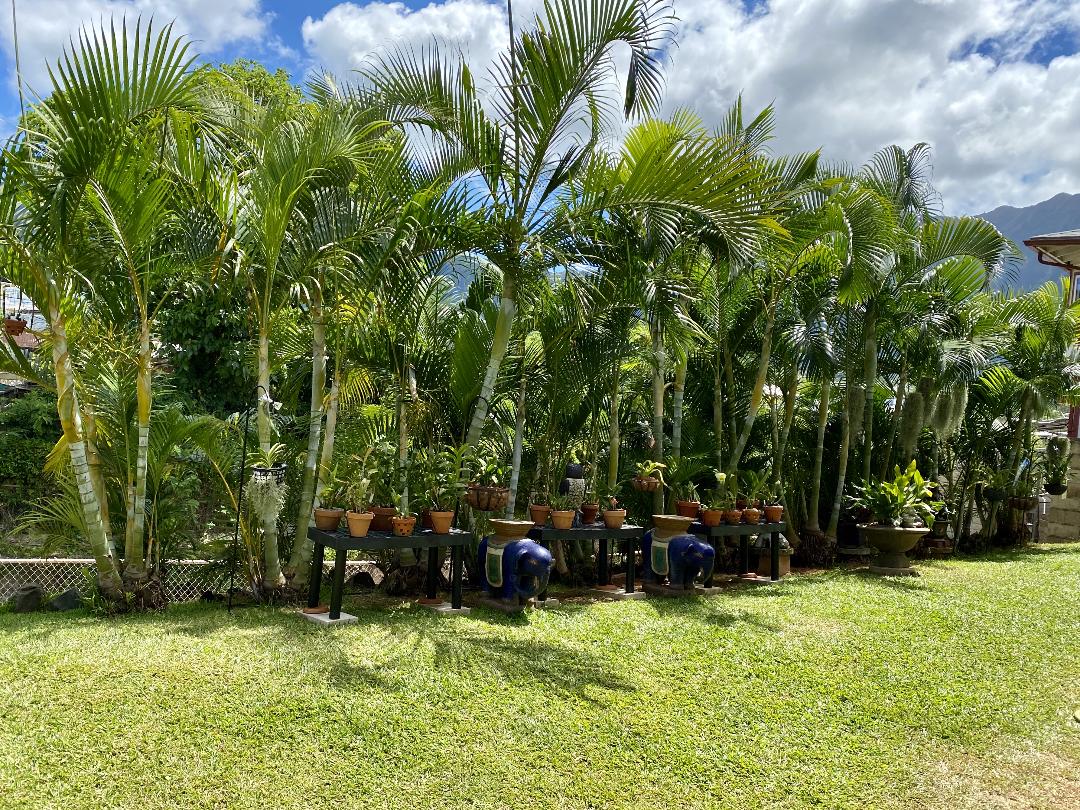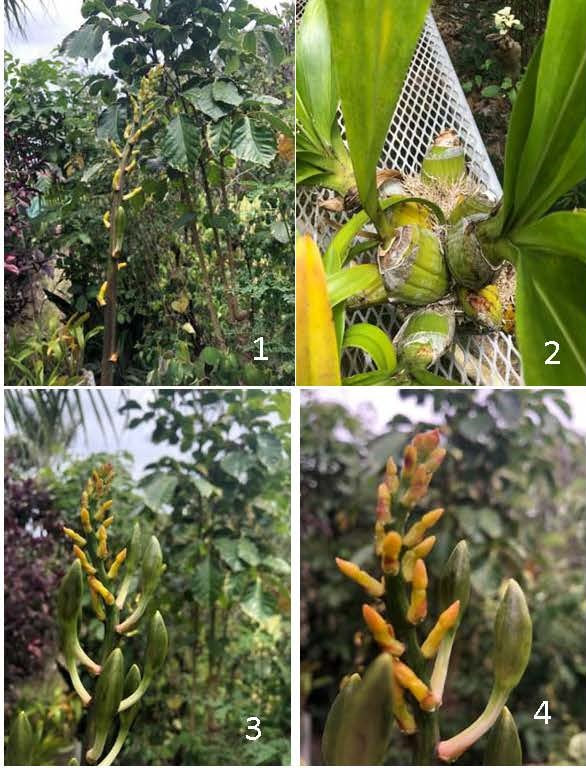Orchid Doctor's Orchid E.R.
Although we must practice social distancing because of the coronavirus pandemic, we want our membership to continue to have information on how best to help their orchids that are not thriving.
So, our Orchid Doctor, Scot Mitamura, is operating from this Orchid E.R. webpage for the time being.
See your newsletters for instructions on how to submit your questions and any pictures of your orchid’s malady. Your questions and Scot’s reply will be posted here.
Please click on the pictures for an enlarged view.
|
2021.02.16
Ctsm. Frilly Doris By Wanda China 02-16-2021 What do I do with this Ctsm Frilly Doris? I had it inside and barely watered it. Now that there are keiki on the bulbs do I leave them alone and start watering it again and bring it back outside, or do I cut the keiki off and pot them separately? Reply by Scot Mitamura Your Catasetum is breaking dormancy, so you can begin watering again, but only after you see new roots. It is still easy to rot the new keikis, as water accumulates easily in the center of the new leaves. If you want to, now is the time to do your dividing or re-potting. |
2021.02.20
Angraecum sesquipedale By Patti Kawahakui 02-21-2021 Yesterday, discovered this pua in the middle of all my hanging orchids. All this time, I thought the plant was a Vanda. Now, with a pua, I think it’s an Angraecum sesquipedale (?) Besides all the rain, what affected her sepals? Thrips? Thank you in advance. Reply by Scot Mitamura Yes you have an Angreacum sesquipedale, from Madagascar. It is often called "Darwin's Orchid". He predicted that a giant moth was the pollenator of this large flower with a long spur. The inflourecence often exudes sticky sugars that will attract flower thrips. You can spray the Bayer 3n1 as the buds emerge. This should take care of it. |
2021.03.22
Eria appendiculata By Barbara Pence 03-22-2021 I received the Eria appendiculata as a gift for my food donation this Saturday. My gratitude, for your generosity! Now I need help. I searched the internet for planting and care instructions, to no avail. I’m wondering if I might seek your advice, on the best way to plant or mount it, light and water instructions. Thank you so very much. Reply by Scot Mitamura Thanks for supporting our WOS food drive. It was a fun event that folks really enjoyed. The Eria is an extremely durable orchid and will adapt to different growing cultures. It could be simply put into a 4" pot with an orchid bark mixture. Mounting it on a piece of bark, cork, of even a basket is also a good option. Just remember that mounting requires more watering and is really good if you are in a rainy area. Allow Erias to slightly dry between waterings and keep them in a bright filtered light area. Fertilize monthly with a water soluble fertilizer, or a time release fertilizer. |
|
2021.02.12
No Name By Kimberly Way 02-12-2021 Is this bacterial brown spot on my two phalaenopsis? Reply by Scot Mitamura The first pic shows you have both a fungal or bacterial infection and some sunburn (lower leaf). Second pic shows a fungal or bacterial infection. My suggestion is to move the phalaenopsis out of any direct sun, unless it is early morning or late afternoon. Trim the diseased areas ahead of the infection. Discard any infected plant parts. Spray the crown with fungicide or Bayer 3n1. Tilt the pots so that future rainwater will run off the leaves instead of accumulating in the crown. This will hopefully discourage re-infection. |
2021.02.13
Paph. Spicerianum By Barbara Pence 02-13-2021 I’m uncertain what’s going on with my Paph. Spicerianum. It’s inside, and was doing fine, until it began turning brown. Looking at the leaves, it was infested with something. Would sure appreciate your diagnosis. Also, should I repot it, or will that just stress it out more? Reply by Scot Mitamura It looks like spider mites. Quite often indoors when the leaves are kept dry, spider mites become a problem. First, spray with Bayer 3n1, making sure you have good coverage, especially under the leaves. In the future try to keep the humidity higher and when watering the Paphiopedilum, it is good to wet the leaves too. This will discourage spider mites from coming back. I would normally not repot it now, but if the media is over two years old, it is probably breaking down, causing root loss and the plant weakening. If you think this is happening, then repot it. Good luck! |
2021.02.13
Ctr Tristar Bouquet By Patti Kawahakui 02-13-2021 New growth is growing outside of pot and has funny color leaves. Why is that and what should I do? Reply by Scot Mitamura Often dark colored flowers with produce anthocyanins in the new growth. This often fades with maturity. My concern is the unevenness or the color breaks. This is a sign of a possible virus. This often is most visible in new growths. No need to panic, keep it isolated and be careful when handling it. Make sure you sterilize well any utensils used on the orchid. Also, avoid letting the orchid water drip on other orchids below it. If the flowers bloom alright and it continues to grow well, you do not need to cull it. But if that changes, trash it without hesitation. |
|
2021.01.21
Hono hono By Wanda China 01-21-2021 My honohono leaves have not all turned brown and dropped off. I reduced watering from every day to 3 times a week in November. Should I water less? Should I cut the leaves off? Please let me know. Reply by Scot Mitamura Completely dry out your hono hono and the leaves will fall off. In December and January really cut back on watering to 1 x per week at most. Your goal is to encourage the plant to go into dormancy. Once the buds are intitiated in February (sometimes later depending on the type), you can resume watering them daily. Good luck! |
2021.01.23
Blc. Burdekin Wonder 'Lake Land' AM/AOS (pictured on the right). By Wanda China 01-23-2021 I bought these 2 orchid plants from an open market vendor downtown, she told me they were both Burdekin Wonder. Can the name be the same for 2 different looking flowers? Reply by Scot Mitamura I'm not sure of the name of the cattleya on the left, but the one on the right looks like Blc. Burdekin Wonder 'Lake Land' AM/AOS. |
2021.02..02.05
Maxilliaria scalaformis By Shannon Gray 02-05-2021 I have a Maxilliaria scalaformis that is fading fast. It did not dry out and has been moist since I received it. I wasn't sure about the light level, but I was getting excellent dappled/filtered light in the late afternoons. My area is largely shady, bright indirect light. At first I thought it was just bud blast, but now it's looking much worse. Please let me know if there's anything I can do. I am worried it may be too late. Reply by Scot Mitamura Your orchid is actually Renanthera Kalsom 'Red Dragon'. This orchid has a high light and moisture requirement. On the windward side it can be grown in the full sun. Since your plant is not receiving enough light and air circulation, it has a fungal infection or crown rot. Using a sterilized pruner cut off the infected crown, and keep cutting until you see clean tissue free of any brown marks. Treat with a fungicide and relocate the orchid to a sunnier location with good air movement. Keep it on the dry side until you see new growths and roots. Then you can increase your watering. Red Dragons are very easy to grow if given the correct conditions. They and have the ability to flower three to four times per year. They quickly get tall and can be a statement plant in your garden. |
|
2020.12.08
Cochleanthes amazon x Amazing By Diane Robello 12-08-2020 What’s causing these brown spots on this orchid (Cochleanthes amazon x Amazing). Thanks in advance. Reply by Scot Mitamura It looks like a fungal or bacterial infection. Cut off diseased leaves about an inch in front of the infection. Keep the plant dry and make sure that you have good air circulation, as these infections are spread by eccesive water. Spray with a fungicide or a 10% household bleach solution. Early detection is paramount, because these infections can spread rapidly and can be devastating to your collection. |
2021-01-13
No Name By Larry Marcum 01-13-2021 What is the disease? Reply by Scot Mitamura Looks like you have a serious infestation of spider mites. The silvering is the scarring that they leave, normally on the undersides of the leaves, but in your case they are all over. The problem probably started in the hot dry summer months. My suggestion is to increase your irrigation (wetting the foliage is OK), this will reduce your chances of them feeding. Remove dead and dried leaves in the surrounding area and spray with the Bayer 3 n 1. It has a miticide in it and should take care of the problem. Make sure you re-treat the foliage as the new growths that appear. The scarring will not go away from the old leaves, but the new leaves will come out great and your plant should be fine. |
2021.01.19
No Name By Nancy and Errol Rubin 01-19-2021 What is this? These are three different orchids. Please help. Reply by Scot Mitamura 01-19-2021 It looks like you are having a fungal infection on all of your three orchids. Unless you spray a preventative fungicidal spray, you will always have some spotting. It is when it gets severe it can become a problem, especially in our wet winter months. My suggestion is to cut off the infected portion of the leaves with a sterilized pruner. Try to keep the orchids on the dryer side if possible. It is also really important to make sure that the surrounding areas and below your orchids are free of old leaves. This is usually the source of repeated infections onto the new leaves of your orchids. Try to keep your orchids a minimum of 18 inches (higher is even better) above the ground, this will help to reduce infections from the soil. You may need to spray them with the Bayer 3 n 1, which has a general fungicide in it. In this rainy weather, fungal infections can appear overnight and can really spread, so take preventative measures as soon as possible. Good job in noticing that there might be a problem. |
|
2020.10.30
No Name By Sharon Matsuyama 10-30-2020 Would you please ask Scott what this is and should it be treated? Thank you. Reply by Scot Mitamura This is something that used to be very common, but not so much any more. You have a common garden slug. This bugger is small, maybe only an inch long or less. Black in color, slimy with a small head with antennae. Like other larger slugs and snails, they come out and feed at night. Because of their small size they are unable to eat completely through the thick Phalaenopsis leaf and just leave a membrane. They can spread very quickly. With the rains we have been getting, all kinds of mollusks are attacking our poor orchids. Treat them with any commercial slug bait. Apply sparingly, but throughout your growing area, in and around your orchid pots. For control it is really important to follow up with a second treatment within two weeks, this will kill any newly hatched young. |
2020.10.31
No Name By Nancy and Errol Rubin 10-31-2020 This was on two of our orchid plants. What is it and how do we treat it? Should we move it out on the collection and isolate it? The thrive solution you suggested has made our whole collection so vary happy. Thank you for your help. Reply by Scot Mitamura This is the residual result of our hot dry summer. Spider mite damage is a silver to blackish scarring, normally on the protected undersides of the leaves, as your photo shows. When bad, it can cover the whole plant! As it gets rainy, the problem usually subsides. So this tells us that more watering was needed in the summer and don't be afraid to wet the foliage, as the spider mites are so small they will have a difficult time to do what they like to do. Feed on the leaves and make more spider mites. You won't be able to fix the damaged leaves, but you want to prevent it from happening to the new growths. Treatment with the Bayer 3 n 1, will get them, because it has a miticide in it. Spray it over the orchid, especially under the leaves and on the new growths. Reapply in a week or so, to kill whatever eggs that was left. This should take you through the winter months, but be aware that the next hot a dry season, you may get a return. Of course good sanitation will help in prevention, so pick up dead and dried leaves, as this can be a source of reinfection. |
2020.11.28 and 2020.04.14
V. Sanchoi 'Spot' By Deborah Collins 11-28-2020 I have this vanda that I think needs repotting. It is a V. Sanchoi 'Spot'. Here are a couple of pictures. If you agree, how do I do that? Should I try to remove the old 4 inch pot? The vanda is about 11 inches tall and the roots are about 56 inches long. I don't think I want to cut these roots as they are still viable. Should I just wind it up and stick it all in a bigger pot? It did not bloom this year. The last bloom was April 2019. The roots are starting to show new growth. I moved it from north to south facing about 6 months ago. Reply by Scot Mitamura Two of your best options would be to either repot it into a larger basket or into a preferably a clay or concrete pot. Since you have active roots, it would be a good time. First wet the roots well, until they are green and pliable. Do not remove the basket, just wrap the roots around the basket old basket and snuggly put it into a slightly larger basket or pot. No media is needed. If the plant is unstable, you can wedge pieces of large bark or styrofoam, so the plant does not move. I also like to stake the plant straight, making sure its really stable. Standard, large flowered Vandas take seven to eight years to bloom, so yours once established, should give you more beautiful flowers. |
|
2020.10.05
C. Volcano Island Volcano queen By Elaine Higa 10-05-2020 I'm enjoying this very red cat. So appropriately named: Volcano Island Volcano queen. It started with 3 buds but the lower 2 rotted and fell off. And of the 6 leaves on the plant only the 3rd one sticking out to right has these black things on the back of it. Yikes, what is it and what should I do??? Reply by Scot Mitamura It looks like your Volcano Island is fine and just needs re-potting. The media is probably getting old so the old pseudo-bulbs will start to die off. After flowering and a day after watering, remove the orchid from its pot. Knock off the old soggy media with your pruners and cut off the dead roots. Remove all old stem sheaths, there could be scales lurking beneath them. Check the black spots of the back side of the leaf, it sound like hard scale. If it is you should be able to just flick them off with your finger nail. Also, feel around for smaller younger scales. After, spray with horticultural oil or insecticide to kill the remaining scales you may have missed. If the spots don't come off it could be spotting from heat damage. It's difficult to tell from your photo. This orchid is gorgeous, and once it "gets a head of steam", don't be surprised if you see five or six flowers per stem! |
Bc. Princess Teresa 'Princess Michiko'
Den. Sonia Bom (Pure White)
By Deborah Collins 10-15-2020 Can you tell what's eating the flowers on these two plants? I'm not sure what to do about this. Reply by Scot Mitamura It looks like you have snail and or slug damage. Your photos show the typical messy damage that they leave. Especially when they eat part of the flower tissue, leaving a thin membrane of the flower skin. It probably came in off your lawn overnight. Treat with any commercial slug/snail bait. Then retreat in a couple of weeks to kill off any babies that may emerge from eggs left behind. Often after dry spells, a little rain will bring out these bad guys in droves, but to see them you need to see them at night. |
2020.10.24
No Name By Diane Robello Scott-can you ID this orchid? I bought it from Koolau Farmers (it didn’t have a tag). Reply by Scot Mitamura I'm not certain, but with high probability it is Ctt. Portia. H & R remade this old hybrid a few years ago and we got some for the auction or Christmas party. I have one too that is in spike. |
|
2020.09.25
Blc Hilda Takamatsu By Patti Kawahakui 09-25-2020 Blc Hilda Takamatsu is the name on the tag but pua look different from other Hilda’s. Is tag wrong or do these pua pull more on the Maika’i side? Reply by Scot Mitamura Yes, the name seems to be correct. The Blc. Hilda Takamatsu you have is a seedling of the cross Lc. Mari's Song x Bc. Maikai. The flowers and growth have inherited more of the Maikai characteristics and less of the splash petaled look of the Mari's Song. This is the reason why I like to grow seedlings, like siblings they all come out different. I really like the color and size of the flowers and the good flower count. Good job! |
2020.09.25
No Name By Patti Kawahakui 09-25-2020 Do you know the name/kinda of orchid this is? She grows on the tree and faithfully gives pua. Pua is about 3” from tip of dorsal sepal to base of lip. Reply by Scot Mitamura This is an easy one, because I also have it blooming. It is an old mericlone from Carmela Orchids, Blc. Hawaiian Charisma 'Hawaii'. The parents are Pot. Hisako Akatsuka x Blc. Mem. Robert Strait. |
Reply by Scot Mita2020.09.30 Blc Hilda Takamatsu By Patti Kawahakui 09-30-2020 Two pua blooming in plumeria tree trunk. Could this be a Blc Hilda Takamatsu which pulls more on the Lc Mari’s Song side? A couple years ago, I kinda think I put a cutting on the tree... Reply by Scot Mitamura Yes, it looks like a Hilda Takamatsu that has taken the splash petaled characteristics of the Mari's Song. |
|
2020.09.11
No Name By Diane Robello 09-11-2020 No name-Scott do you know the name of this orchid? Reply by Scot Mitamura This is a good one. Cycnodes (Cyn) Wine Delight 'JEM' FCC/AOS. Great color and wonderful fragrance. |
2020.09.19
Hono Hono By Wanda China 09-19-2020 What is this on my hono hono leaves? First it was on one cane but now it's moving to the other canes. I have other hono hono plants and it's not happening on the other plants. I did treat it with 70% isopropyl alcohol, do I need to use something stronger? Reply By Scot Mitamura It looks like a really bad infestation of Red Spider Mites. This usually happens in the summer when it is hot and dry. So increase watering and treat the hono hono with the Bayer 3 n 1. It has a miticide in it to kill them. The alcohol will not strong enough. Spiders are harder to kill than most insects. The white damage will not go away, but don't worry the leaves will fall off in the winter anyway. Do a repeat application in about a week to kill the emerging eggs. Try to get really good spray coverage, especially under the leaves. The new leaves will emerge and be fine. Because you caught it in time, this should not hinder flowering next year. |
2020.09.20
Thecopus secunda By Patti Kawahakui 09-20-2020 I removed these leaves from this Thecopus secunda. What is going on? Also, less than having to remove all the affected leaves, what should I do to save her? Reply by Scot Mitamura Wow, what a nasty infection. It looks like some kind of fungal or bacterial infection. You can see the black spot and a ring around it. Cut off the really bad leaves and discard. Try and spray with the Bayer 3 n 1. It has a fungicide in it that might do the trick. There is no repairing of the old leaves, but spray them well on both sides and spray the new leaves to help prevent the spread. If that does not work then you may need to use a bacteriacide like Agristrepe. Physan 20 or a 10% bleach solution may also help. Try to keep the plant out of the rain for now, to help dry things out. I hope this works, keep me updated on your treatment. |
|
2020.08.20
Honohono By Diane Robello 08-30-2020 What’s eating the leaves on my honohono? This one is mounted on my mango tree, but it also happened to potted ones hanging in another tree. Only the first couple leaves are munched, the rest are fine. Reply by Scot Mitamura It’s those darn slugs or snails again. Your photos show the typical sloppy feeding habits. Often leaving the harder mid ribs of the leaves while feeding on the softer tissue. Yes, they will climb up trees for their favorite meal. Treat your whole area with any commercial slug bait, then the key is to do a second treatment in two weeks to kill the emerging young. |
2020.08.31
Gur bowringiana ‘Volcano Queen' By Patty Kawahakui 08-31-2020 Bought this Gur bowringiana ‘Volcano Queen.’ When she arrived, she had healthy buds. I watered her and three of five buds looked bad, so I took them off. The remaining two did the same thing. 🤦🏽♀️ Did I over water? Reply by Scot Mitamura You did nothing wrong. It is called "bud blast". Some orchids in bud just do not ship well. Bowringianas just happen to be one of them. Sometimes it could be the ethylene gas that builds up inside the closed box and other times it could be from extreme temperature changes on the airplane. Anyway, the orchid should be fine, but you just need to wait till next year to see it bloom, since bowringianas are once a year bloomers. |
2020.09.05
Dimerandra stenopetala By Diane Robello 09-05-2020 How do I remove keiki at the top of this? Do I just cut? Will old cane send up new keiki at the bottom since it won’t flower after it’s cut at the top? Reply by Scot Mitamura Dimerandra stenopetala is a great species to grow. They commonly send out keikis from the top of the pseudobulbs. Once they are showing good roots, like the ones on your plant, you can remove them and pot them individually or together. If you do not remove them, they will take some of the energy from your main plant, hindering new shoots from forming below. Sometimes if the root system is dying the orchid is forced to develop keiki's on top. So, make sure to check to make sure that you don't have any rot forming at the base, especially if the media is old. If you do, a repot may be necessary. Dimerandras are normally problem free and like lots of water. Dimerandras rebloom multiple times from the top of the stem, so just cut off the keiki at the joint leaving the top of the main stem intact. This way the stem may continue to rebloom. Since Dimerandras like moisture, I have had good success in potting the keikis in a small clay pots with sphagnum moss. |
|
2020.08.12
Den. King Dragon By Wanda China 08-12-2020 I bought this den king dragon a couple weeks ago and now that the flowers have died I think I need to do something with this plant. Should I just repot it in a bigger pot, or split the plant and put all the tall stalks in one pot and all the shorter stalks with the new growth in another pot? What would you do? Reply by Scot Mitamura Looks like you have a nice healthy Dendrobium. Yes, if it could talk, it would be saying to please re-pot me! I would recommend that you split the orchid into two plants. It looks like right down the middle would be best. It's a good time, looks like you have some new roots and growths, plus its summer. Loosen up the old media and remove the old bark and dead roots. Re-pot them individually into two pots, it looks like they are in 4" pots. It is always good to separate the large side of the plant from the smaller side, this would allow the small side to get the sunlight it needs. Pot them into a bark or blue rock media and you should be fine. One secret is, especially for the taller half, is to stake it up with bamboo firmly, so that it does not wobble. Add more stakes if it keeps wobbling. A wobbling orchid will struggle to root well. My favorite thing to do is to additionally wedge firm pieces of styrofoam in the bottom of the pot. Do this as tight as possible, then I stake it through the styrofoam, often I will be able to pick up the orchid by its stem without adding any media. Now add the media to the top. I know this orchid will establish well. Anyway you choose, the Dendrobium is an easy orchid to grow and you should have no problem with it. |
2020.08.20
Den. Diane Shimazu x Waianae Blush x Den. Sirum ‘Orange’D By Diane Robello 08-15-2020 Scott, what is wrong with this Den. Diane Shimazu x Waianae Blush x Den. Sirum ‘Orange’? Reply by Scot Mitamura The fused leaves on your Dendrobium is an uncommon occurrence. It is thought that its cause could be from a genetic mutation often exacerbated by the mericloning process. There is no cure for this, and the condition may come and go. You may try to split and open the leaves down the middle or remove the leaves completely. If all the leaves continue to fuse you may need to discard the orchid. I actually have a few that have done this with this line of breeding. I ended up tossing mine. |
2020.08.27
Cadetia Funiformis By Shannon Gray 08-27-2020 I have a Cadetia Funiformis that started to become very dry and all the leaves are falling off. It is so small, I am not sure it can be salvaged...photos attached. Thanks so much. Reply by Scot Mitamura I'm glad you took notice to the leaves dropping. This is normally a symptom that something is going on with the orchid. The first response that most orchids have when they are over or under watered, is the dropping of leaves. The two apparently opposite reasons are actually the same reason. If an orchid is over-watered and the roots begin to die, the orchid will exhibit the symptom of leave drop to try to balance transpiration, because it is unable to take up water effectively. This is especially true with Dendrobiums, after a couple of days of heavy rain, they start dropping leaves like crazy. The opposing reason of under-watering, results in the same net effect, the orchid is unable to take up enough water to balance transpiration, so it drops leaves. So let’s look back on what has been happening with your Cadetia. Could you have been giving it too much water? I notice that the older pseudo-bulbs are a light brown in color, often this is an indication of a bacterial infection. If the bulbs are soft, you will need to remove them. If they have a sour odor, then you know you have a bacterial infection. Make sure you sterilize your pruner (with heat or a 10% bleach dip solution), especially before you make your final cut, so you don't spread it to the healthy front half of the plant. You can actually spray some of the 10% bleach solution on the orchid to help control the bacteria spreading. On the other end, if it is not bacterial and you have been neglecting the orchid, just increase your watering, and maybe even some misting might help it through our hot dry summer. If the old roots seem to be dying, if the hapuu mount is old (become grayish in color and getting brittle and dry quickly), you may want to remount the Cadetia on a fresh piece. Of course, first removing the old drying pseudo-bulbs. Cadetias like a lot of moisture and humidity, but they also need good air circulation. If the area that it is grown has stagnant air, it would be a good idea to move it into a better area. If hope this information helps and doesn't make things more confusing. |
|
2020.07.18
Bllra. Tropic Lily 'Chocolate Drop' By Diane Robello 07-18-2020 What is this jelly-like substance on this orchid? Reply By Scot Mitamura This is a strange one. I have seen it only once before. I think the damage on the pseudobulb is from a moth caterpillar, possibly a Corn Ear Worm. The moth lays eggs on the leaf and the caterpillar emerges and crawls down into the leaf axel to feed. Of course it is the wrong type of food, so it abandons the orchid with minimal damage. The gel like substance is just exude from the orchid in reaction to the caterpillar feeding. Clean the affected area looking for boring caterpillars and spray with an inaecticide. The orchid should heal and send out a new growth. |
2020.08.01
Dendrobium aggregatum, now called lindleyi By Steve Canham 08-01-2020 A very unhappy Den. aggregatum. On hapuu, in basket, hanging in maybe 3/4 sun. Another Den. aggregatum right next to it (in one of Karen’s pots) is thrilled and blooms annually. This one bloomed heavily for its former owner (on the hapuu), but I’m killing it. I tried it originally in less light, but it wasn’t happy there either. In two years it hasn’t bloomed once. New growth is weak. I water regularly and foliar fertilize. Diseased? Diagnosis? Reply by Scot Mitamura The older hapuu gets, the dryer it becomes, and after a while many orchids will start to decline. Dendrobium aggregatum, now called lindleyi, likes to grow in tight clumps. If not grown this way, they do not thrive and rarely will they bloom. My advice is to treat them like the successful pot. Remove the plants from the hapuu by scraping just under the roots, starting from the dead sides. Now cut away the old dead stems, trying not to damage the front lead areas. Make three to four lead bulb divisions and then bunch them together, keeping the leading ends on the outside. Wedge them into the smallest pot you can find and apply a little of the media you successfully used in the other pot. The key is keeping them bunched together, this provides the optimum moisture that it needs to survive. They are slow growing, so don't be surprised that it might take you a couple of years before they get enough energy to flower again. They hate to be divided and are only happy when they are in a group. |
2020.08.02
Who am I? By Bianca Kam 08-02-2020 Would you believe my tag says “sharry baby tuk I sayonara???? Reply by Scot Mitamura Luckily, I have this orchid, so I am familiar with it. It is Gombrassitonia (formerly Aliceara) Helmut Rohrl 'Carmela'. Named after the German mathematician. This is tricky one because he has several Oncidinae hybrids named after him. This is a good one, and fairly easy to keep it alive. |
|
2020.07.08
No Name By Bianca Kam 07-08-2020 Help! I can’t keep any phalaenopsis alive! This was moved outdoors 3-4 weeks ago.. Not sunburn - top leaf is partly green where it covers the yellow leaves below. It’s been in shade. Leaves are firm - not old age as the older leaves still look healthy. Roots look ok. Media looks ok, though I had considered changing it after the flowers faded last month. Fertilizer burn? I put half tsp. of your pellets 3 weeks ago (after flowering). Watering only about once a week, on weeks with no rain. This noname had 3/4 - 1-inch size pink blossoms on spikes that branched. Reply from Scot Mitamura Based on the great clues you have provided; I believe that it has been subjected to heat stress from being moved from the inside to the outside. This is different from sunburn, where the heat is more localized and you would see the burnt tissue on the highest leaves, here you have the symptom of yellowing leaves on the upper part of the plant, especially the center portion where the heat would accumulate the most. This is why your lower leaves are still green and your root system is still strong. Don't fret these things happen in the heat of summer, just be really aware of what is happening when you move plants to different locations. Keep the plant cooler and in more shade, the yellow leaves will fall, but don't be surprised if you get a new growth from the base of the stem. |
2020.07.18
Rl digbyana ‘Seafoam Beauty’ x Frills By Patti Kawahakui 07-18-2020 Didn’t know this orchid had a bud. Found the bloom today. Why are the leaf tips and leaf purple and why did the back of the flower get black and deformed? Mahalo! Reply by Scot Mitamura The leaf tips are turning brownish is an indication of desiccation due root loss. This plant probably needs to be repotted. The black on the back of the flowers appear to be a fungal infection. Keep the plant dryer and increase air circulation. To keep digbyanas happy, they also like very bright filtered light. They are hardy orchids and are difficult to kill. |
2020.07.27
No Name By Bianca Kam 07-27.2020 Can you identify this orchid? The blossoms usually appear in late May or June. There were 3 spikes on this plant Mui I had thought it was cymbidium dayanum from a photo in an orchid magazine but recently saw a photo of aliofolium. I repotted in styrofoam and bark and expect that it will fill the 12 in pot in about 2 years. Reply by Scot Mitamura You are correct, it is Cymbidium aloifolium. It is often confused with Cym. dayanum, but differs in it's rounded hour glass lip shape. A warm growing, pendent flowering species from S. E. Asia, is easy for us to grow here into large specimens. It will do well with your media selection. Aloha, Scot |
|
2020.07.05
See the picture below of the same flower the day before 07-04-2020 By Patti Kahawakui 07-05-2020 Orchid today - petals turned more purple 😆 |
2020.07.05
Dendrobium By Elaine Higa 07.05.2020 I'm wanting to repot this Den. At the left that new shoot is growing downward. I know.... I know I should have done it sooner. ...but I procrastinated. How would YOU do it? Reply by Scot Mitamura Two things, either leave it alone or cut the shoot to allow another one to emerge, hopefully it would be facing upright. You always have the chance that it does this when you hang or mount your orchids. Many actually like to grow downwards. |
2020.07.06
No Name By Patti Kawahakui 07-06-2020 Is this Blc “Rustic Spots”? When blooms, the pua are purplish. Then as it ages, it goes yellow. Reply by Scot Mitamura Hmm, a tough one to decide. Many of the B. nodosa hybrids can look similar. Blc. Rustic Spots could possibly be correct as the hybrid was made here in Hawaii by H & R Nurseries, but normally the spotting would be larger, from the Landate parent. I'm leaning towards Bl. Yellow Bird. Which was also made in Hawaii, has the smaller spotting and does the same change in color. Some cultivars have lots of spotting where others would have very little, oh it also has an inflorescence that is quite long. Either way I doubt if anyone could definitely say one was right or wrong. |
|
2020.06.27
No Name By C.J. Kalopodes 06-27-2020 Found this blooming in my yard. No tag on it Reply by Scot Mitamura It looks like a Dendrobium clone named after a local AOS judge and former HOS president, Den. Ruth Chun's Gemini. Aloha, Scot |
2020.07.03
Phalaenopsis By Errol Rubin 07-03-2020 We are having a problem with the orchids pictured below. They came from a collection that a friend gave us. Errol repotted them with black cinder and your special mix. They looked fine before the repotting and had slight dehydration, and Nancy I thought it was because she sprayed neem on them that was extra strong, so we thought they would recover. At his point they have infected a complete other shelf that were not in that section. They are super limp, and do not respond to water, continually shriveling up. Reply by Scot Mitamura You have nothing to worry about. The phalaenopsis orchids that you repotted will take a little more time to recover. Unlike other orchids with stems or pseudobulbs, phalaenopsis store their food reserves and water in their leaves. It looks like these plants have lost all of their live roots, so it will take some time before the leaves plump up again. In the meantime, increase your watering, foliar fertilizing (balanced or high phosphorous to encourage good root development), and even some plant hormones (Superthrive or hormex) would really encourage root development. In a few months you will see lots of new roots develop. The firmness in the leaves should return and I wouldn't be surprised if you get some flowers this coming winter season. Good luck! Aloha, Scot |
2020.07.04 No Name By Patti Kawahakui 07-04-2020 Do you know the name of this orchid? Found her in bloom to celebrate the 4th of July. Mahalo! Reply by Scot Mitamura Sorry, cannot positively identify this orchid. It looks like it could be a primary hybrid with Cattleya intermedia as one parent, as they are blooming now. The other parent, if I had to guess would be Cattleya amethystoglossa, which would make it Cattleya interglossa. Cattleya interglossa comes in all types of forms, typo (which yours would be), aquinii (splashed petals), coerulea (blue), alba (all white), and even spotted. The clues are the blooming season, bifoliate leaves, and the cut lip. Aloha, Scot Note: The next day, the petals changed color. See picture dated 07-05-2020 |
|
2020.05.27
Slc. Jewel Box 'Scheherazade' AM/AOS By Steve Canham 05-27-2020 I was just given this blooming Noname by a friend. I’m not sure if the plant is clean or virused. The one inflorescence looks sketchy, but could just be old? The livelier one has some mottling and maybe odd curling, but doesn’t look horrible. Leaves etc. look good. If I am keeping it and not throwing it into the big gray Tomb of the Unknown Orchid, do you have any idea of its name? Thanks, Scot. Reply by Scot Mitamura Hi Steve, It's an oldie but goodie! It is probably a mericlone that has been done several times, but last done in Hawaii in the early eighties. It is Slc. Jewel Box 'Scheherazade' AM/AOS. Because of it's age, I would suspect that it could be virused. In fact I believe that the mother plant that was cloned, was probably virused to begin with. I had the same clone for many years and it never looked very "clean". It is a famous plant that, if allowed to, can develop into a huge specimen plant. I'm glad you still have it alive. Take care of it, as it can often bloom around our spring show. Aloha, Scot |
2020.06.21
Ett. Volcano Trick ‘Volcano Queen’ By Deborah Collins 06-22-2020 Is this orchid rot? Or just the normal color for this new growth? How can you tell the difference? Reply by Scot Mitamura This is a tricky one and difficult to tell from your photos. I believe two things are happening. One is the new growths, which are really tender, may have gotten too much sun. Fortunately, only the leaf sheaths have been slightly burnt; but your leaves are alright. So there should be no permanent harm to the orchid. Also, with greater light intensities, and dark colored flowers certain orchids will express anthocyanins or pigment in the foliage. This is completely normal and is often confused with rot, except if it is rot, it would become soft and would spread throughout the new growth and not be localized to only one side. Just remember it's summer time and we need to be concerned about over heating our orchids. Double check the direction of the light and keep your orchids well watered with good air circulation. Aloha, Scot |
2020.06.21
Blc. Golden Zelle x Blc. Oh Suzannah ‘Lake View’ By Deborah Collins 06-22-20 I had these promising buds, but then a couple of them got sick and fell off!!! Some of them did bloom, but what killed the other buds? Reply by Scot Mitamura Your picture shows that your cattleya is nice and healthy. Despite the general health of the plant, sometimes the bud fails to form properly or fully and they sometimes abort. A recent moving of the orchid to a different area could also cause the bud to abort. The second bud opened perfectly, and the aborted bud looks fine, so it does not appear to have any insect problem. So, if you haven't moved it recently or the weather has made an abrupt change, I feel that it is just an aborted bud and you should have nothing to worry about. One note, you may want to log this on your label. There are certain orchids that are known to consistently "bud drop". If this happens often it could just be a characteristic of the orchid, and if it gets really bad where all the buds drop, then you may want to discard the orchid. Aloha, Scot |
|
2001 Catalog
Dendrobium wasselii vs Dendrobium linguiforme By Patti Kawahakui 05-08-2020 I think Steve Canham’s orchid is Dendrobium wasselii vs Dendrobium linguiforme. (See Steve's contribution 05-04-2020) His orchid looks my orchid which I bought from H&R back in 2001. The reason I think Steve’s is a wasselli is cause the plant bulb is long and slender vs short and stubby. Reply by Scot Mitamura Thanks Patti for the correction! Upon checking my label, it also said Den. wasselii. This is what happens when you try to go by memory only. So Steve please accept my apologies and make the name change. I'm glad to see that folks are checking up on me. I often say that when I don't know something, I just make things up. Shucks I can't do that any more, you guys are just too smart! |
2020.05.15
Cymbidium By Diana LeFebvre 05-19-2020 I’m wondering if I should repot this cymbidium? I picked it up at the 2019 WOS Orchid Show and repotted into its current arrangement in May 2019. So it’s only been a year, but it lives outside in Kaneohe near Pohai Nani, so it gets quite a bit of rain at times. The medium in the pot doesn’t look too bad, but the roots are coming out of the bottom of the plastic pot concern me. It has produced only one new growth since I’ve had it. Should I leave it alone? Or cut the pot off (it’s become brittle) and repot? Also, is regular medium bark ok, or should I use anything else? What would you advise? Reply by Scot Mitamura Go ahead and repot the cymbidium. It has new growth that should be sending out new roots. Cut away and discard the old pot and cut off any dead roots. Most of them may already be dead. Live roots should be plump and firm. Dead roots will be light and hollowed. Most Cymbidium growers cut back all of the roots, because the old ones die off quickly. Just plain bark will work fine. Cymbidiums are heavy feeders, so fertilize regularly (a balanced fertilizer is fine), especially going into the long summer months. |
2020.05.16
Green House By Diana LeFebvre 05-16-2020 I do not have a shade/greenhouse, so when not in bloom, most of my orchids live on the North side of the Areca palm hedge in the photo that I try to keep trimmed back. It works pretty well, even if they get too much rain at times. I use scare tape, shiny twirly things and an owl that I move periodically to keep the bulbuls away which has worked well for several months. What concerns me is the ever-thriving mealy bug and scale infestation in the palms. Anole lizards have completely wiped out the ladybugs, so I rotate between BioAdvanced 3-in-1, insecticidal soap (Natria), and a Neem oil/dish soap mixture, but their numbers keep growing and I’m afraid the pests will eventually spread to my orchids. Do you have any other suggestions I could try? Reply by Scot Mitamura Your non greenhouse set-up looks ideal. The areca palms provide the perfect dappled light that the orchids love. I like how you are keeping the areca palms thinned, so that they don't block out too much sunlight and air movement. I am surprised that you are having so much problems with the mealy bugs; It normally happens when the arecas are too bushy, but they always have mealy bugs in their leaf sheaths where they are protected. For control, use what you are using, but focus on getting the spray into the leaf axils, where it can penetrate under the leaf sheaths. If that does not help, there is a insecticide called Marathon. It is a granular, systemic insecticide that will surely get them. I try not to use it, because the chemical is the one that affects bees. Overall, I think that the mealy bugs will mainly stay on the arecas and not affect the orchids too much, so they might never become a major problem. When watering, blast the arecas with a strong spray of water, this may keep the mealy population down to a manageable level. You have found the key to success with the Bul Bul Bird deterrents, and that is to keep moving them. Everything looks good, there is not much to improve on with your set-up and culture. Continue what you are doing and you will surely have success in growing orchids. |
2020.05.01
|
2020.05.04
No Name By Steve Canham 05-04-2020 Can you identify this tiny little orchid? I’ve had it for a decade and just remounted it today. I’m pretty sure that it came from Wilbur, and I long ago lost the tag. My guess is Eria javanica, but that’s just a guess based on an on-line search. The individual flowers are an inch long. Reply by Scot Mitamura I know this one, because mine is blooming too. Yes, it originally came from Wilbur Chang and later from H & R Nurseries. I think it is Dendrobium linguiforme, from Australia. It's leaf shape can be somewhat variable. I have seen photos of it with a more prostrate growth habit, with flatter pseudo bulbs. It either grows on rocks or trees. It likes lots of light, just short of full sun and likes to be kept on the dryer side. NOTE: 05-08-20 This conversation continues...see above contribution by Patti Kawahakui and Scot Mitamura |
2020.05.03
Grammatophyllum By Bianca Kam 05-03-2020 Thrips or lack of water? Or??? My black thumb?? Applied 3 in one about a month ago. Watering 1-2 times a week. In full midday sun but sheltered from am sun by hedge and pm sun by lime tree. This one has only one bud developing. The other was doing well until the tip got yellow. Don’t know why I didn’t notice when I watered last week. The second plant. The spray is about 3 feet tall. Second plant close-up of buds. Reply by Scot Mitamura Yes, it's the darn flower thrips again. This time of year and the air is getting hot and dry, the thrips will attack our orchids. You should get good results using the Bayer 3 n 1, but the key is in the application timing. It should be applied a little earlier in the spike development, before the individual flowers separate from the main flower spike. The thrips like to get in between the very young buds and their protective flower sheath. Here they are protected and can do their feeding undisturbed. The 3 n 1 has a systemic insecticide in it, so apply it earlier and maybe once more, since the Grammatophyllum spikes are so long, and that should do the trick! Otherwise the plants look fine. |
MeetingsThe Windward Orchid Society meets at 7:30 p.m. on the first Wednesday of every month at the King Intermediate School Cafeteria, located at 46-155 Kamehameha Hwy. in Kaneohe.
|
Become a memberJoin the Windward Orchid Society to help promote, educate and show an appreciation of one of the most beautiful and exotic of all plants. The Orchid.
Join WOS Today!
|
|
© Copyright 2017, Windward Orchid Society, Inc., a non-profit organization. Website Designed by Highgauge.com |

